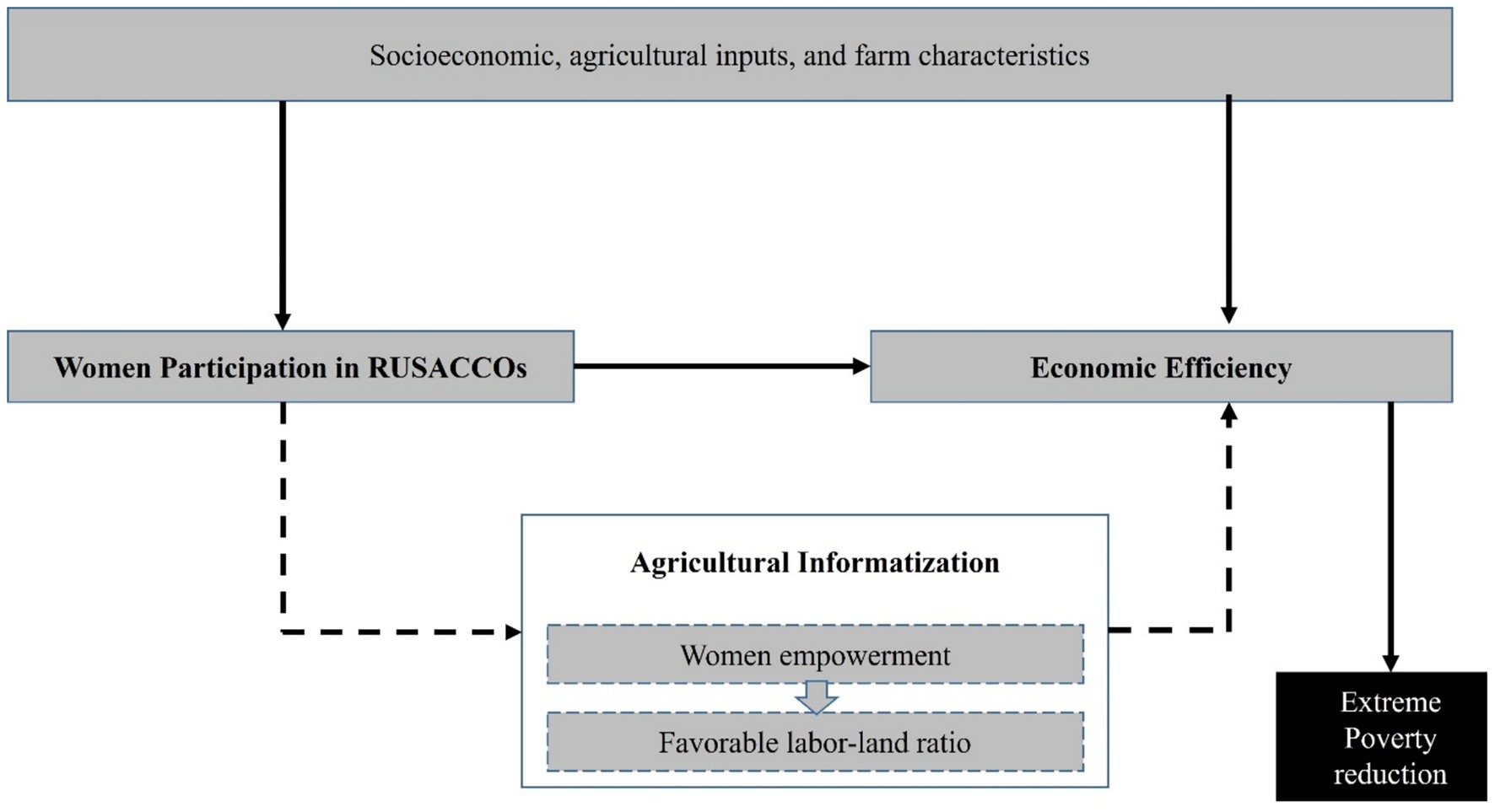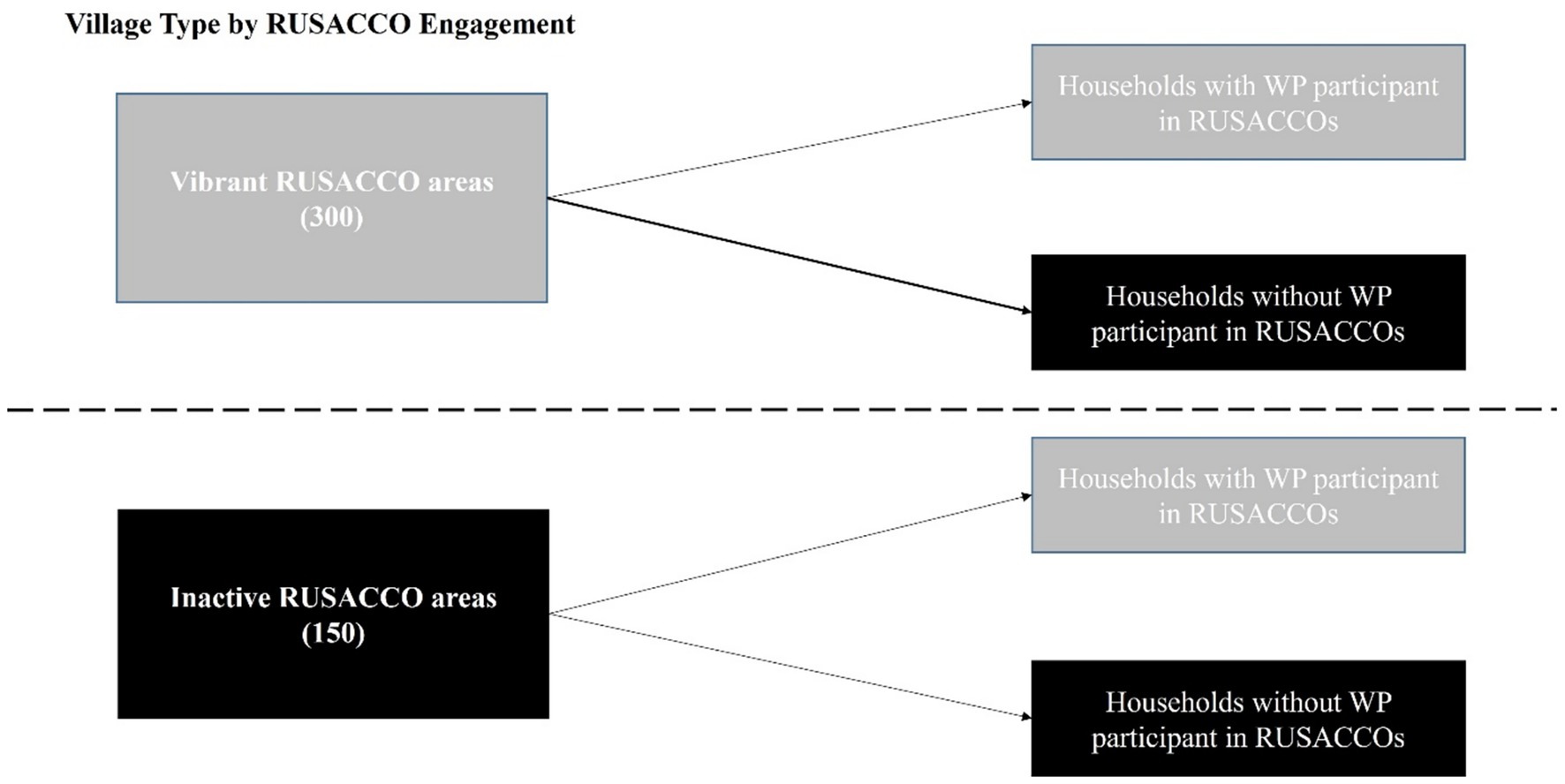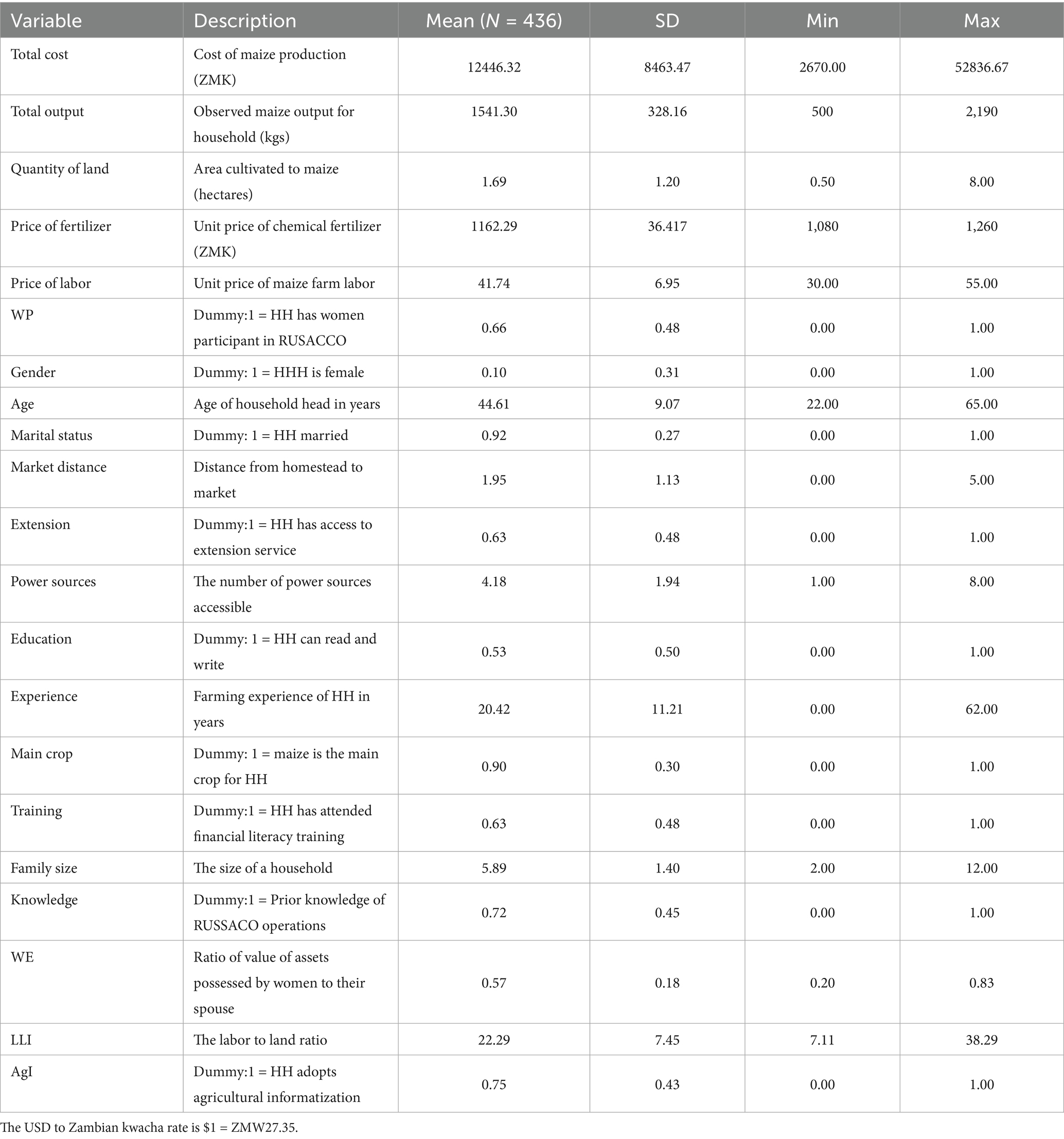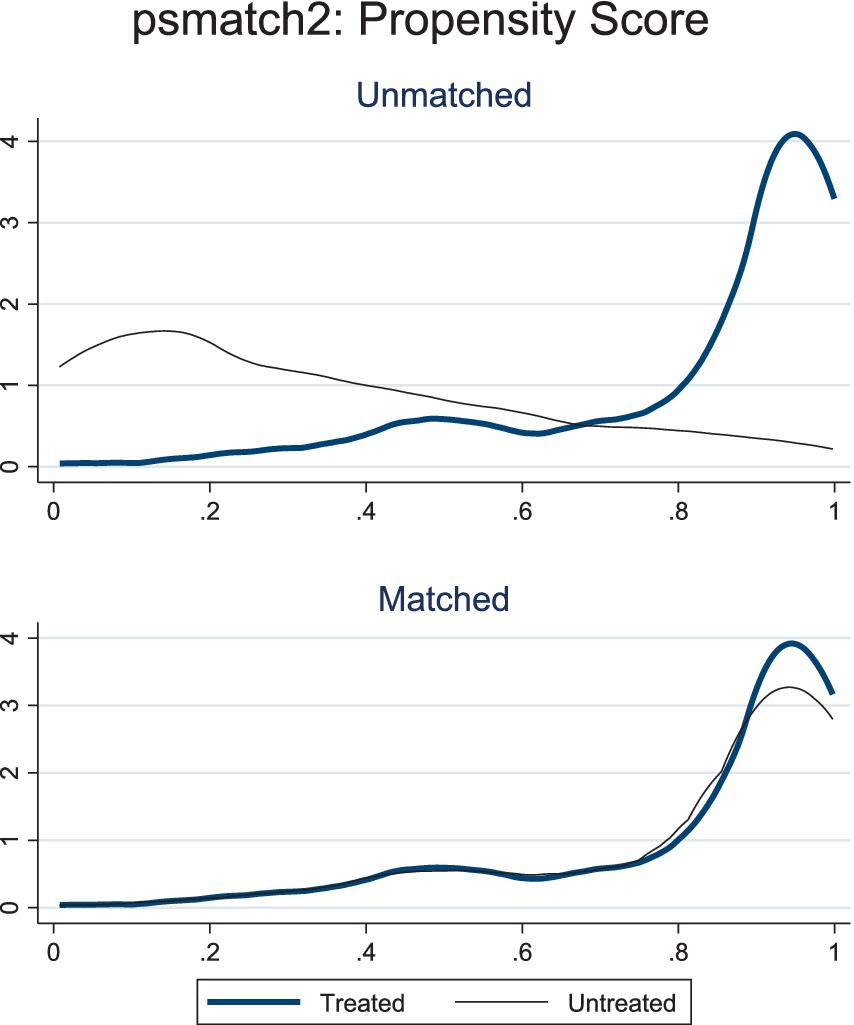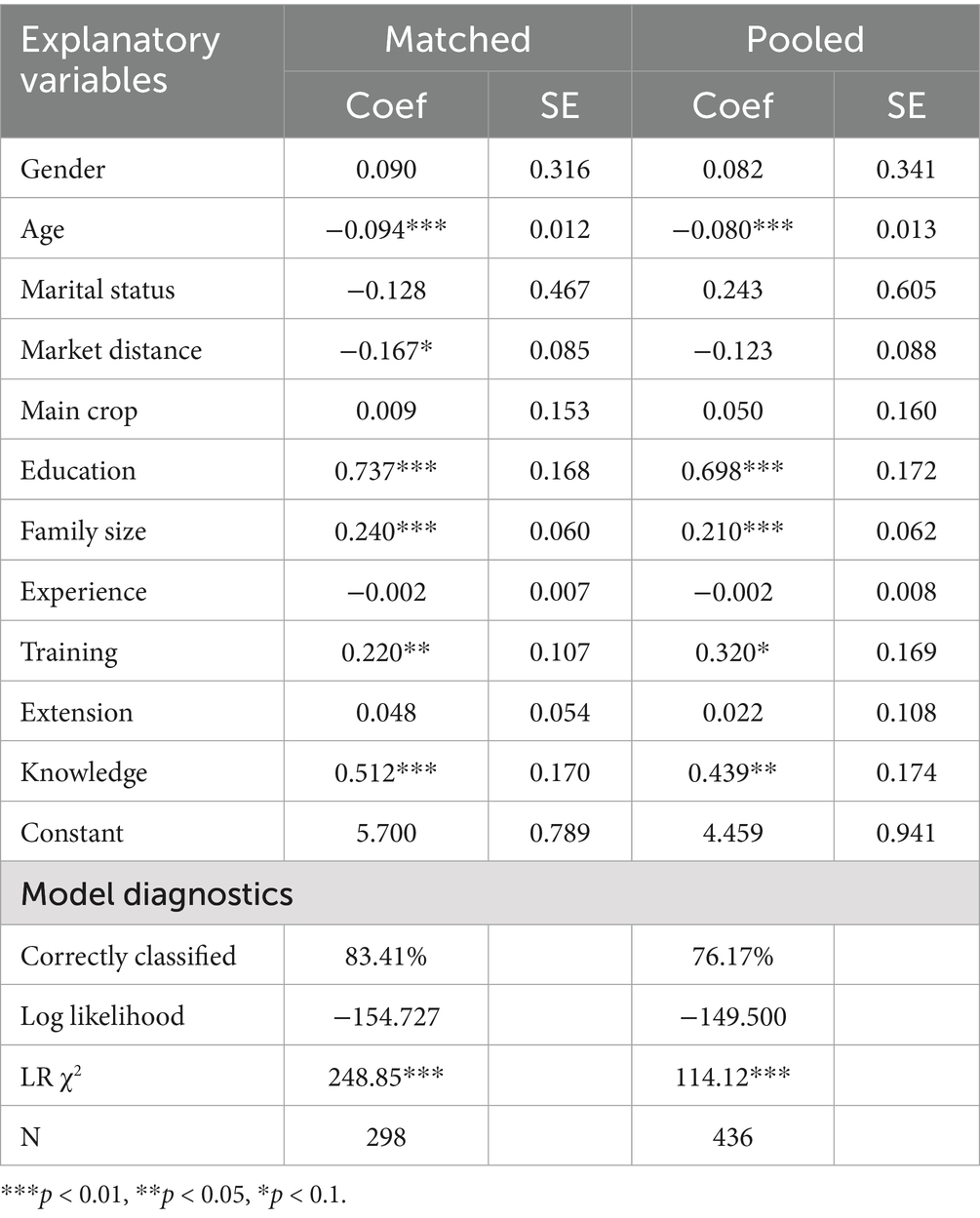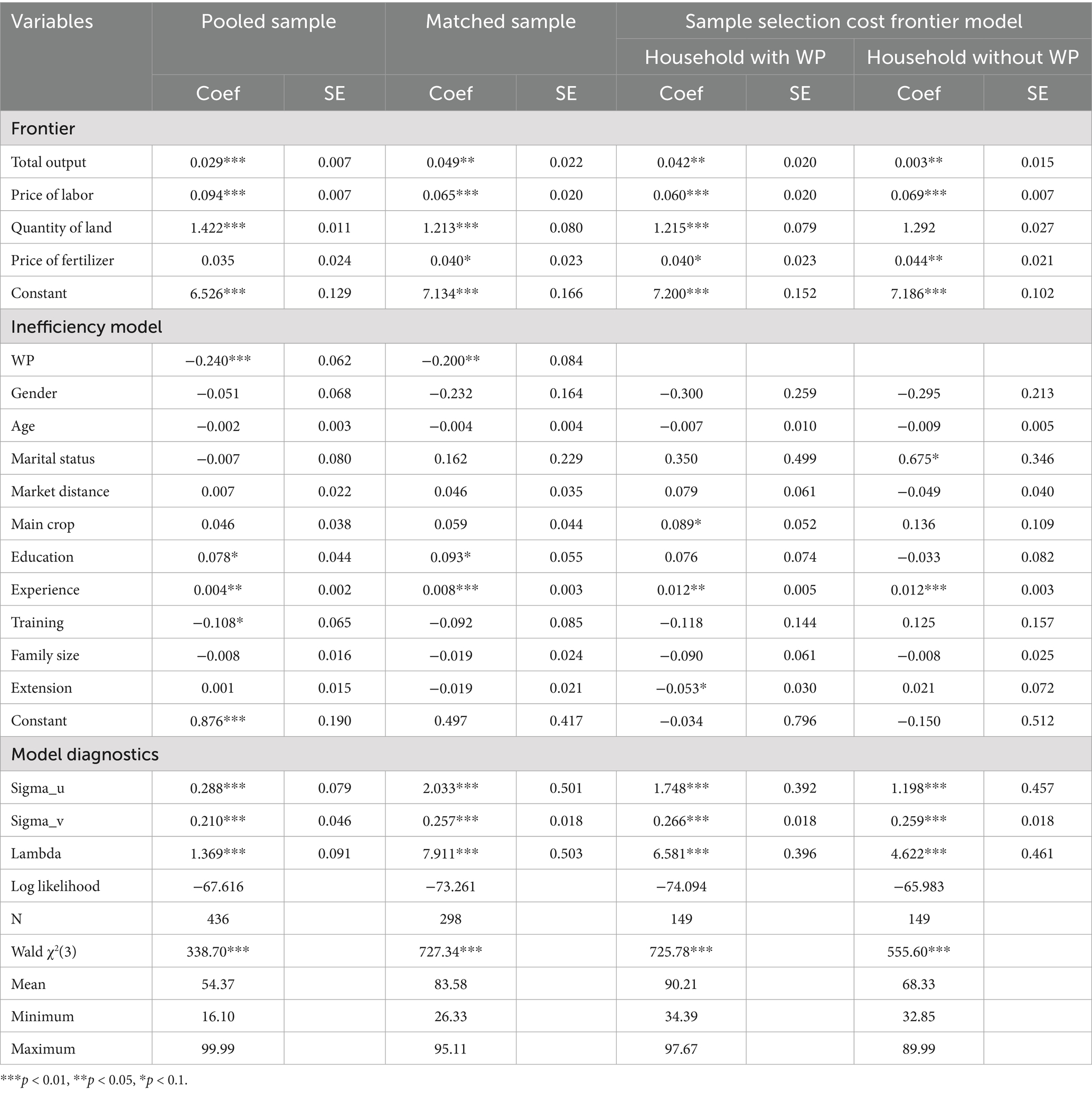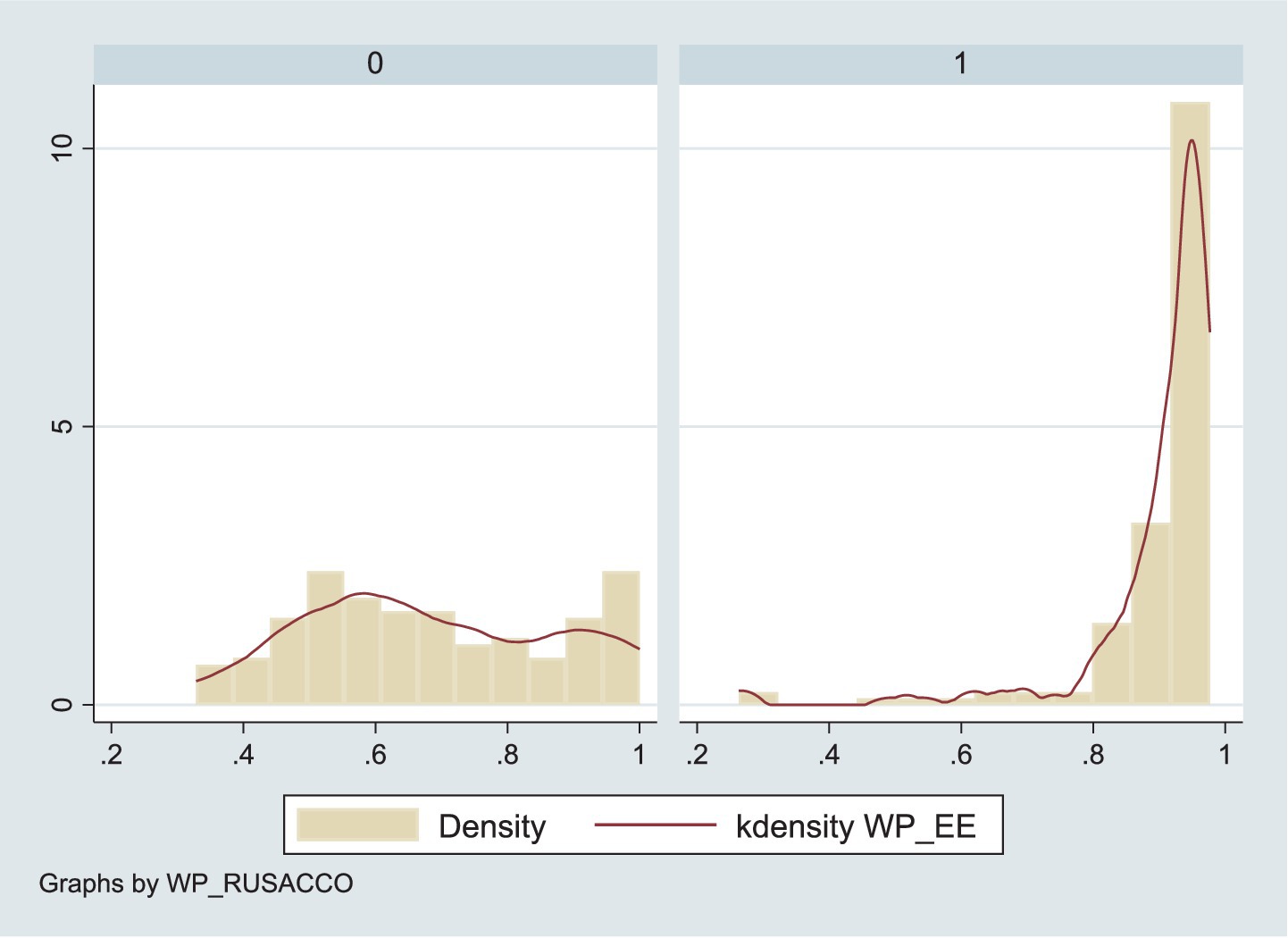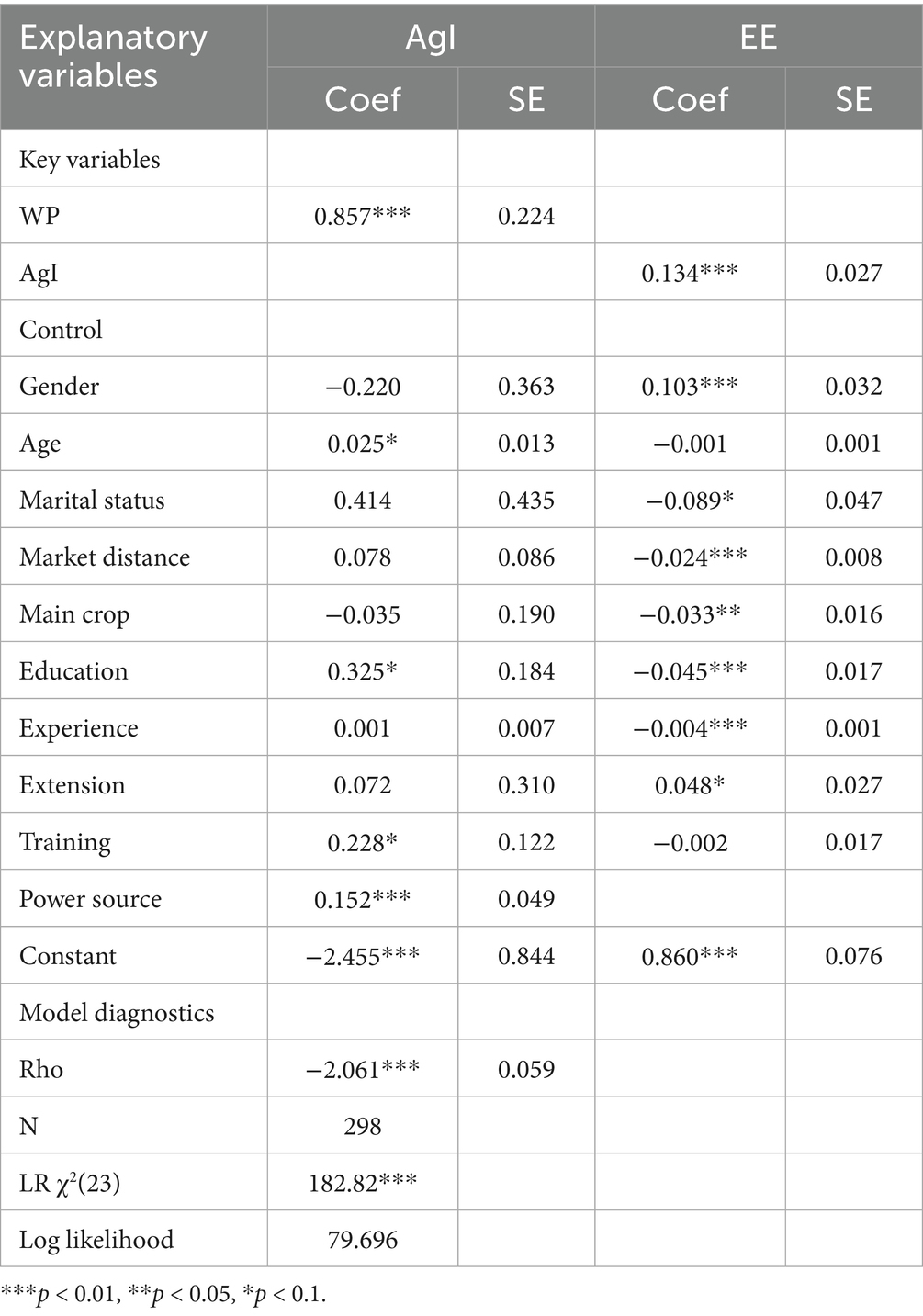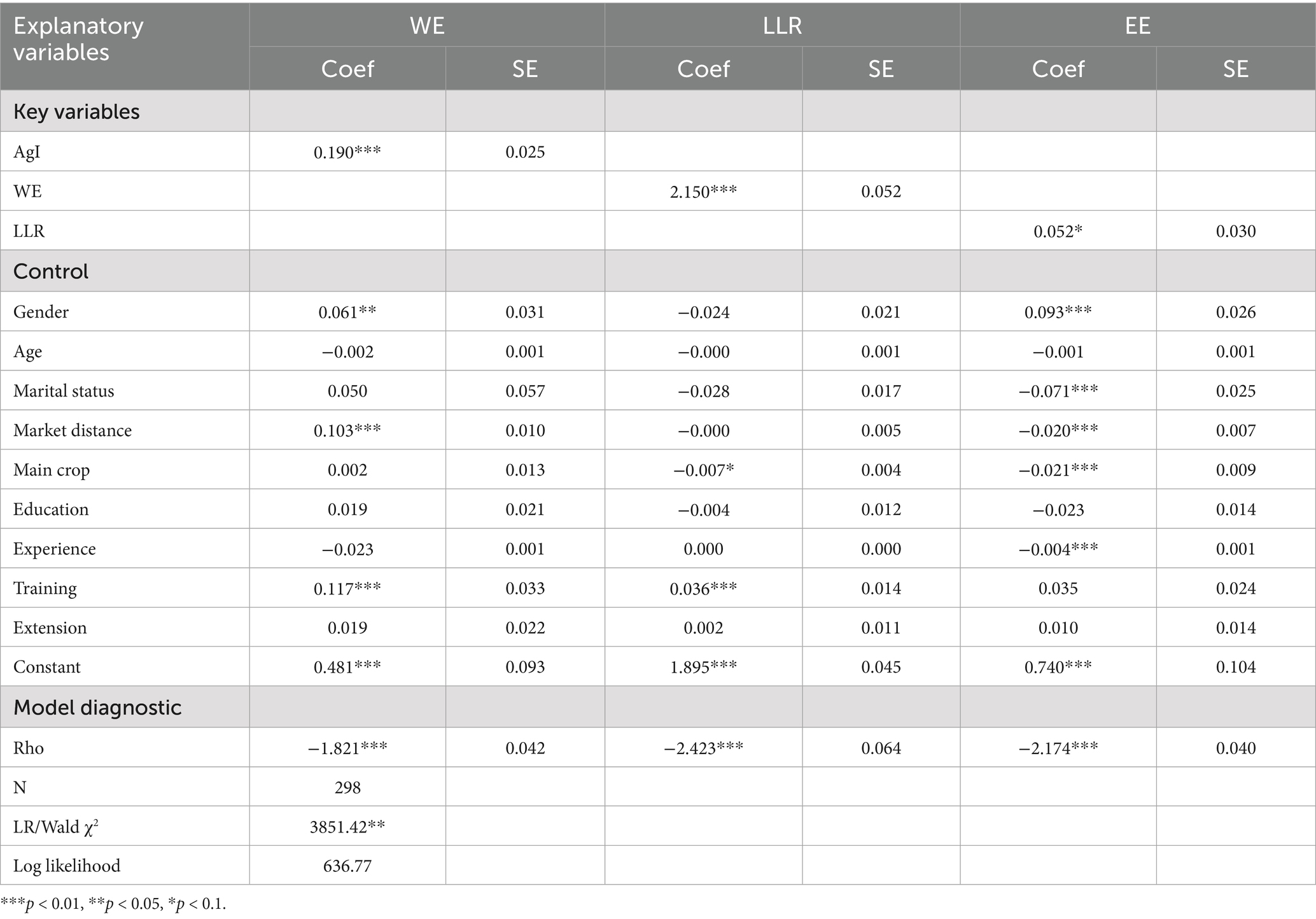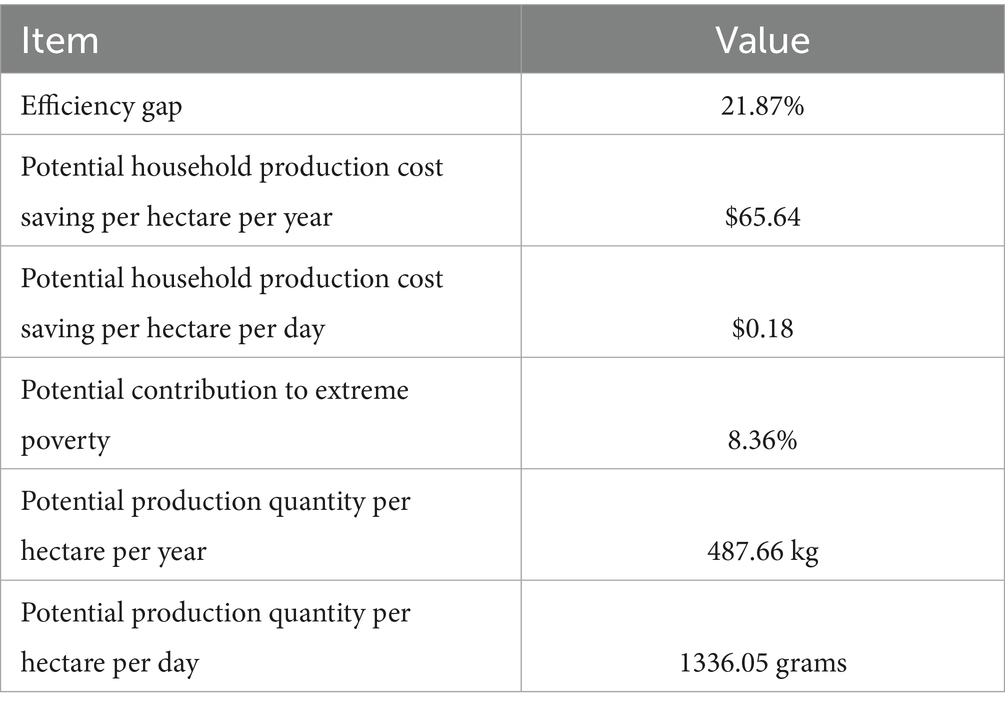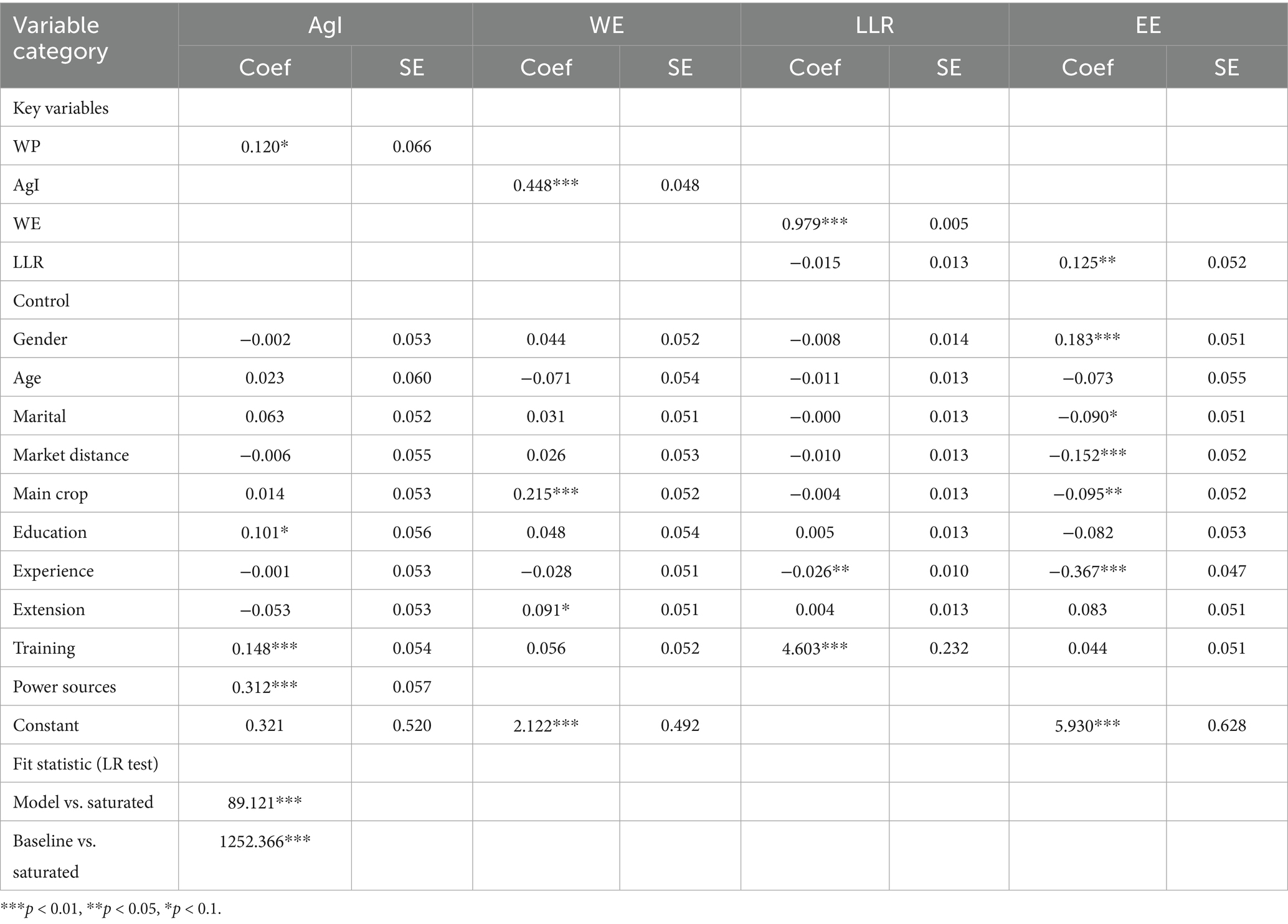- 1School of Management, Nanjing University of Posts and Telecommunications, Nanjing, China
- 2Department of Agriculture and Agribusiness, Prince G Consultancy and Academy, Kabwe, Zambia
- 3International Business School, Hainan University, Haikou, China
- 4Department of Agricultural Finance and Management, Sher-e-Bangla Agricultural University, Dhaka, Bangladesh
Women in agriculture face significant barriers to land and resources, limiting their contributions to productivity and poverty alleviation. Despite extensive literature on women’s roles in agriculture, the effect and mechanisms of women’s participation (WP) in smallholder financial inclusion programs like Rural Savings and Credit Cooperatives (RUSACCOs) on economic efficiency (EE) in maize production remain underexplored. This study addresses this gap using data from 436 farm households in Zambia. Employing sample-selection stochastic cost frontier analysis, we find that WP in RUSACCOs significantly enhances EE. Notably, households without WP could improve cost efficiency by 21%, potentially reducing extreme poverty by 8%. Moreover, the findings identify agricultural informatization (AgI) as a compelling mediating mechanism: by empowering women and optimizing labor-land allocation, AgI amplifies the efficiency gains associated with WP. Overall, the study underscores the transformative potential of informal financial inclusion initiatives, such as RUSACCOs, that are gender-inclusive in advancing sustainable development goals (SDGs) 1 (poverty), 2 (hunger), and 5 (gender equality). Accordingly, policy implications emphasize the need for integrating smallholder financial inclusion programs with agricultural informatization support to strengthen the agricultural value chain and support broader socio-economic development goals among women farmers in rural settings.
1 Introduction
Financial exclusion adversely affects agricultural productivity, often compelling farmers to turn to inefficient and costly alternatives (Appiah-Twumasi et al., 2022; Batung et al., 2023; Sharma and Zhao, 2017). This issue is particularly pronounced in developing countries, where a large proportion of farmers, especially women, face considerable challenges in obtaining credit from formal financial institutions. These challenges largely stem from stringent requirements for collateral-free credit, which even land ownership does not always overcome (Batung et al., 2023; Missiame et al., 2021; Sharma and Zhao, 2017). Although governments have introduced micro-credit programs to empower women and enhance their participation in income-generating activities, the impact on agricultural productivity growth remains modest. Notably, persistent constraints on rural farmers’ access to agricultural credit continue to undermine the effectiveness of these initiatives particularly in terms of improving economic efficiency (EE)—defined as the ability of farmers to achieve minimum costs in producing a technically efficient output level—in crop production, a critical aspect of agricultural development (Doss, 2018).
A promising development has emerged in the form of informal savings and loan groups, exemplified by Rural Saving and Credit Cooperatives (RUSACCOs) or village banks (Sishumba and Mulonda, 2019). These institutions have attracted substantial women’s participation (WP), with participants not only contributing valuable additional labor in agriculture but also serving as potential agents of change in fostering agricultural efficiency and productivity (Ashe and Neilan, 2014; Dlamini and Mpanza, 2020; Rickard, 2022; Schoofs, 2022). Particularly, RUSACCOs offer essential savings and loan services to rural people who would otherwise not have access to financial services. With a presence in approximately 75 countries across Latin America, Asia, and Africa, and over 17 million active participants worldwide, of which 78 percent are women, RUSACCOs play a crucial role in providing financial inclusion to marginalized communities (Karlan et al., 2017; Kesanta and Andre, 2015). The model of RUSACCOs emphasizes saving, asset-building, and provision of credit facilities tailored to the needs and repayment capacity of borrowers.
Fundamentally, the RUSACCO model offers a promising strategy for advancing agricultural development in agricultural-dependent countries like Zambia, where women’s participation remains disproportionately low despite their critical role in the sector (Mwanamwenge and Harris, 2017; Samboko et al., 2018). While recent years have seen improvements in financial access and inclusion due to the expansion of service providers—including commercial banks, microfinance institutions, cooperatives, and informal lenders—Zambia still lags behind other developing nations in these indicators (World Bank, 2019). Notably the continued lack of sufficient financial resources, coupled with limited alternatives to combat the impacts of climate change, pose a serious risk to the country’s food security. In particular, maize production, a cornerstone of household consumption and national food policy, continues to suffer from low economic efficiency and structural vulnerability.
Responding to these challenges, the Scottish government, in partnership with Christian Aid (CA) and Norwegian Church Aid (NCA), launched the Making Agriculture a Business (MAB) project. This initiative targeted marginalized groups, particularly women, aiming to improve livelihoods and build resilience. A core component of the project involved the formation RUSACCOs to facilitate financial access and enhance the cultivation and marketing of various commodities. Recognizing the limitations of agricultural extension services, the project emphasized agricultural informatization (AgI))—the use of digital tools and services to support agricultural processes—to empower women by improving their access to assets and funds. This approach also sought to encourage greater participation of women in agriculture, fostering a more balanced labor-to-land ratio and addressing systemic inefficiencies. Given that crop productivity of African farming systems remain abysmally below the potential, the MAB initiative represents a progressive intervention that aligns with calls for modernization and inclusive development. Consistent with development economics and ex-ante risk mitigation theories, such initiatives help smooth household consumption, stimulate investment in productivity-enhancing technologies (e.g., certified seeds and efficient fertilizers), and offer safeguards against income and yield losses (Bertolozzi-Caredio et al., 2021). Ultimately, financial access, technological adoption, and gender empowerment converge to support poverty alleviation and the sustainable transformation of agriculture in Zambia.
However, despite years of investment in smallholder financial inclusion programs, such as RUSACCOs, it remains unclear whether WP can contribute to realizing EE in maize production. Although RUSACCOs and women’s empowerment have received considerable scholarly attention, a significant research gap remains. Most existing studies have concentrated on adjacent aspects such as productivity (Dawuni et al., 2021), income effects (Amponsah et al., 2023), and challenges faced by RUSACCOs (Bannor et al., 2020; Brunie et al., 2017; Schoofs, 2022). Aligning more closely with the interests of this study, a recent investigation by Appiah-Twumasi et al. (2022) explored the impact of innovative financing on economic efficiency in maize production. While the study provides important insights, it presents two notable limitations. First, the role of women’s participation in innovative financing initiatives was neither adequately emphasized nor systematically analyzed. Second, although the relationship between participation in innovative financing and economic efficiency was robustly established, the study did not empirically explore the mechanisms driving this relationship. Therefore, this study aims to address these knowledge gaps by examining two key scholarly and policy questions: First, is WP in RUSACCOs associated with improved EE in maize production for rural farm households? Second, if so, what are the underlying mechanisms or potential pathways?
Consequently, this study makes a significant contribution to the discourse on sustainable agriculture by elucidating a critical aspect of the agricultural value chain, namely the effect and mechanism of WP on EE. These insights carry important implications for policymakers seeking to design inclusive and transformative interventions for sustainable agricultural development. This contribution is particularly significant given that, although women are responsible for producing 80–90 percent of food in Africa, they make up only 50 percent of the agricultural labor force (Botreau and Cohen, 2020; Glazebrook et al., 2020). This imbalance highlights the transformative potential of gender-focused financial inclusion programs in enhancing agricultural productivity and efficiency.
However, merely understanding whether WP enhances EE is insufficient for effective policymaking. It is equally essential to elucidate the direct and indirect pathways through which WP influences EE, particularly given that this relationship is less straight forward. This study makes a unique contribution by applying econometric methods to investigate the mediating role of AgI, a variable that has been underexplored in the context of improving EE among smallholder farming households. AgI is increasingly recognized as a “game-changer” for smallholder farmers in Africa (Agyekumhene et al., 2018; Duncan et al., 2021), offering transformative potential to enhance access to knowledge, boost productivity, and improve food security (Goedde et al., 2021). To the best of our knowledge, this is the first study to analyze the mechanisms by which WP, mediated through AgI, affects EE, specifically via pathways such as women’s empowerment and adjustments to the labor-to-land ratio. Understanding these broader effects is critical, particularly in the context of the United Nations’ Sustainable Development Goals (SDGs), which aim to address a wider array of development challenges beyond a narrow set of economic development metrics. Therefore, the study provides robust evidence to support policy frameworks that foster gender inclusivity and sustainable agricultural development.
Overall, this study contributes to the ongoing discourse on women’s economic empowerment within the context of agricultural development, providing valuable policy implications by addressing both the effects and mechanisms of financial inclusion programs. These insights equip policymakers with the tools to design targeted interventions that not only improve access to financial resources but also enhance their effective utilization. Such efforts are critical for achieving sustainable improvements in agricultural productivity and economic efficiency.
Importantly, focusing on maize production in Zambia is especially significant due to its critical role in the value chain and market linkages. Firstly, maize is a staple food in Zambia, and improving its economic efficiency directly impacts food security by ensuring a steady supply, stabilizing prices, and enhancing availability for consumers (Burke et al., 2011; Mwalupaso et al., 2019). Secondly, maize production is a significant economic activity for smallholder farmers, and enhancing productivity can increase farmers’ incomes, stimulate local economies, and reduce poverty levels (Mason et al., 2020; Sihlobo, 2018). Finally, understanding and improving maize production can strengthen the entire maize value chain, from input suppliers to processing and marketing, ensuring that farmers can sell their produce at fair prices, promoting sustainable agricultural practices and economic growth (Burke et al., 2019; De Groote et al., 2023).
The remainder of the article is structured as follows: section 2 presents the conceptual framework, followed by the materials and methods in section 3. Section 4 details the empirical results and discussion, and section 5 concludes the study.
2 Conceptual framework
Informed by the production function (Aigner et al., 1977; Battese and Coelli, 1992; Battese and Coelli, 1995) and the theory of induced innovations (Janvry and Sadoulet, 2006), the conceptual framework posits that WP in RUSACCOs can significantly influence EE, as illustrated in Figure 1. The framework recognizes that limited WP in agriculture often stems from restricted access to productive assets (Amponsah et al., 2023; Rahman, 2010). By participating in RUSACCOs, women gain access to credit, which alleviates these constraints and facilitates the acquisition of digital tools such as mobile phones and radios. These tools especially the mobile phone serve critical functions, including accessing agricultural information, conducting mobile money transactions, and improving market linkages (Batista and Vicente, 2020; Kikulwe et al., 2014; Mwalupaso et al., 2019; Sekabira and Qaim, 2017b).
From a theoretical perspective, women’s empowerment can be understood through the lens of Kabeer (1999) empowerment framework, which highlights resources, agency, and achievements as key dimensions. Access to credit and digital tools enhances women’s resources and agency, enabling them to make informed decisions and engage more effectively in agricultural production and markets. This process aligns with Sen’s Capability Approach, which posits that access to resources (e.g., credit, technology) enhances individuals’ capabilities to achieve valued outcomes (Kuklys, 2005; Sen, 1979). Noably, embracing AgI enables women to acquire productive equipment and assets, consistent with finding by Sekabira and Qaim (2017a). This adoption can alleviate labor constraints in maize production by optimizing the labor-to-land ratio (Rasheed et al., 2020). This mechanism is consistent with the principles of the household production theory by Boserup et al. (2013) and Pollak (2003) which suggests that labor-enhancing technologies optimize land productivity (Darity, 1980). Moreover, the emphasis on AgI in this framework underscores the role of diffusion of innovation theory (Rogers et al., 2014), which posit that access to information and communication technologies facilitates innovation uptake, productivity gains, and resource optimization.
In sum, the framework suggests that WP through RUSACCOs facilitates the adoption of agricultural informatization, which in turn mediate economic efficiency through two key pathways: (1) empowerment, and (2) improved labor-to-land ratio. These improvements in EE are expected to contribute to broader goals such as poverty alleviation.
3 Materials and methods
3.1 Description of the study site
In Zambia, smallholder agriculture forms the backbone of rural livelihoods and national food security, yet it remains predominantly traditional and low in productivity. The majority of farmers rely on rudimentary tools such as hand hoes for land preparation, depend on family labor, and utilize minimal modern inputs—a situation that reflects structural inefficiencies within the sector (Mason et al., 2020; Sibhatu et al., 2022). Maize is the principal crop cultivated nationwide, playing a critical role as both a staple food and a source of income (Silva et al., 2023; Workman, 2018). However, Zambia’s agricultural sector is increasingly vulnerable to multifaceted challenges, including threats from climate change, land degradation, diminishing soil fertility, and prevalent pests and diseases. For instance, during the 2017/18 farming season, maize production in Zambia amounted to 2.4 million tons, marking a decline of 34% from the previous year and 20% from the 5-year crop record. This production level was 14% lower than the country’s consumption needs (Sihlobo, 2018). Additionally, during the 2023/24 farming season, the government declared a national disaster due to a severe drought that drastically impacted food production and electricity generation. This drought, the worst since 1981, led to the destruction of crops, including maize along with livestock losses, exacerbating poverty and food insecurity for more than 9.8 million people (WFP, 2024).
Among the various initiatives aimed at addressing Zambia’s agricultural vulnerabilities, the MAB project stands out for its targeted strategies designed to transition smallholder farmers from subsistence to commercially viable agriculture. These two key approaches include: (i) forming common interest groups, such as self-help groups and savings groups, to enable community members to collaborate in improving the cultivation and marketing of various commodities, and (ii) establishing farmer-training centers (demo sites) to facilitate capacity building and skills transfer. Participation in these savings groups is voluntary, with each group limited to a maximum of 30 members. Notably, all MAB groups adhere to a constitution governing their operations, including aspects such as leadership selection, term of office, loan interest rates, and loan management. These groups determine their meeting schedules and frequencies within a month.
Given the challenges associated with accessing formal credit, RUSACCOs in project areas have the potential to empower women participants in maize production and address fluctuating production levels, which are believed to contribute to Zambia’s classification as the third most hungry nation globally in 2015 (GHI, 2016) and among the most hungry nations in 2020 and 2023.
3.2 Data
The study primarily focused on engaging smallholder farmers in the four districts where the MAB project operates, gathering data between July and September 2022. Ethical clearance for the study was obtained from Prince G Consultancy and Academy, with all participants providing voluntary consent. Maize production quantities, costs, and input prices were captured for the 2021/2022 farming season, while the recall period for other key variables is detailed in section 3.3.
Employing a multi-stage sampling technique aimed at mitigating program placement bias, two agricultural villages with comparable socio-economic conditions and infrastructure were purposively chosen in each district—Chisamba, Kapiri-Mposhi, Kabwe, and Mumbwa. Within the villages, two groups were delineated based on MAB activities, separated by approximately 35–40 kilometers: areas with active MAB participation were categorized as “vibrant RUSACCOs areas,” while those lacking such activities were labeled “inactive RUSACCOs areas.” This approach, recommended by Tambo and Wünscher (2018), aimed to address program placement bias. The sample size was determined following Cochran (1977) criteria for known populations (N = 3,600) presented in Equation 1 at a 95% confidence interval, resulting in an expected sample size of 450 participants. However, to account for program placement bias, 300 from vibrant RUSACCO areas and 150 from inactive RUSACCO area were selected and are inclusive of both participants and non-participants as shown in Figure 2. The final analysis utilized 436 observations due to missing data for 14 respondents.
Where 𝑛 = Sample size, 𝑁 = Population size, 𝑍 = Z-value (1.96), 𝑝 = Estimated proportion of an attribute present in the population (50%) and 𝐸 = Margin of error (5%).
Data collection employed a structured and pretested questionnaire administered by experienced enumerators to minimize measurement error. The enumerators primarily targeted the household head and their spouse for data collection to ensure comprehensive and accurate responses. Since most households cultivate a single plot of land, the agricultural input and output data collected specifically pertain to the household’s maize plot.
Triangulation was achieved through key informant interviews (KIIs) with various stakeholders, including project staff, agronomists, training center community facilitators, and lead farmers. Recognizing the susceptibility of EE estimates to measurement errors, a rigorous data cleaning protocol was implemented. Outliers were identified and verified against field notes, and cross-validation with original survey forms ensured transcription accuracy. Range checks were applied to key variables, and enumerators received extensive training to standardize data collection techniques. Robustness checks confirmed that the results were stable even after excluding potentially erroneous observations. To mitigate potential data recall bias, information from the immediate past farming season was collected, aligning with recommendations by Tarrant et al. (1993) and Connelly et al. (2000). Additionally, questions were framed with specific seasonal references, and wherever feasible, data were triangulated with secondary sources to mitigate recall bias.
Summary statistics of the sample are presented in Table 1. It is important to note that family labor was quantified by aggregating the self-reported hours spent by household members on maize farming activities, including land preparation, planting, weeding, and harvesting. To value this labor, we used the prevailing regional wage rate for agricultural labor. This approach ensures that the opportunity cost of family labor is reflected in the analysis and aligns with common practices in agricultural productivity research.
3.3 Definition and measurement of key variables
The main explanatory variable of interest, WP in RUSACCO, is defined as a dummy variable measured at the household level. It takes the value of 1 if at least one adult woman in the household has participated in RUSACCO for two consecutive years, including the survey year, and 0 otherwise.
For the potential pathway analysis, three variables were considered: AgI, women’s empowerment and, labor-land ratio. AgI is captured as a dummy variable, with one representing a household where an adult member used digital tools to support agricultural processes in the survey year, and 0 otherwise. On the other hand, women’s empowerment is measured in terms of the proportion of short- and medium-term productive assets in monetary value owned by women or jointly by male and female household members within a household. This concept of asset ownership is commonly utilized in the literature to assess the economic situation of women within households. To mitigate potential issues of reverse causality, only assets such as agricultural equipment (hoes, saws, wheelbarrows, sprayers, etc.) and vehicles (bikes, motorbikes, trucks, etc.) were considered, excluding highly durable assets like land or buildings. Thus, a larger proportion of such assets owned by females or jointly owned by male and female household members indicates a higher degree of women’s empowerment (Sekabira and Qaim, 2017a). Lastly, labor-land ratio is the quotient of the labor-hours by land area which reveals the amount of labor hours per hectare.
Finally, EE serves as the outcome variable estimated through stochastic frontier analysis (SFA).
3.4 Empirical strategy
To achieve the main objective of this study, which is to evaluate the effects and underlying mechanisms of women’s participation in RUSACCOs on economic efficiency, we employ a rigorous and multifaceted empirical strategy. First, we apply a sample selection SFA, combining propensity score matching (PSM) and stochastic cost frontier (SCP) techniques, to assess the relationship between WP and EE. The use of these advanced econometric techniques ensures reliable and robust results, providing deeper insights into this critical relationship. Subsequently, we explore potential pathways using conditional mixed process (CMP) modeling and structural equation modeling (SEM). To enhance the robustness of our findings, we employ the pooled and matched sample. Additionally, emerging themes from key informant interviews were incorporated to corroborate and enrich the empirical results, providing a more nuanced understanding of the findings.
3.4.1 Sample-selection SFA
Stochastic Frontier Analysis (SFA), formulated by Aigner et al. (1977), is a parametric approach on which efficiency measurements rests; the general form of the cost function is as specified in Equation 2;
Where is the total expenditure incurred by the ith farmer to produce output; is a vector of farm input prices; is a vector of parameters to be estimated. The SFA model incorporates a composite error term that accounts for random disturbances ( ) and cost inefficiency ( ).
Accordingly, Battese and Coelli (1995) advance that the determinants of cost inefficiency can be specified as presented in Equation (3);
Where is a vector of factors that may influence the level of cost inefficiency including WP and α is a vector of parameters to be estimated.
However, the relationship between WP in RUSACCOs and EE is complex, as individual farmer characteristics can influence both production outcomes and the propensity for women to engage in savings cooperatives. For example, well-organized and meticulous farmers are likely to achieve higher levels of EE by optimizing the use of their input packages. Concurrently, these same traits may also make women more likely to save money and join savings cooperatives, such as RUSACCOs. Additionally, unobservable factors also play a significant role in both participation and efficiency outcomes. For instance, risk attitudes, ranging from risk-averse to risk-loving, can significantly impact women’s decision to join a RUSACCO and their ability to achieve economic efficiency. Similarly, unobserved traits like self-efficacy and intrinsic motivation may influence both production outcomes and the likelihood of participation. These unobservable factors can introduce selection bias, where certain types of women are more likely to participate in RUSACCOs, leading to confounded estimates of the program’s true impact. As a result, correlations between WP and EE do not inherently demonstrate causality, underscoring the need for a rigorous empirical strategy to disentangle these effects.
To mitigate these issues, the study incorporates robust bias correction methods to account for both observable and unobservable heterogeneity. These approaches rely on established methodologies advanced by Bravo-Ureta et al. (2012) and Greene (2010), ensuring that the estimated impacts of WP in RUSACCOs on EE are both credible and causally interpretable.
In impact evaluation, a comparable counterfactual group of farmers—who share similar pre-selection characteristics but do not receive the treatment—is compared to those who have been treated. As an initial step in the estimation process, this study adopts PSM, which controls for observable factors influencing both RUSACCO participation and EE by matching participants with non-participants who have similar characteristics (Rosenbaum and Rubin, 1983; Sianesi, 2001). By restricting comparisons to farmers within the region of common support, PSM approach effectively eliminates any bias in treatment effects related to observable characteristics of farmers, thereby ensuring that comparisons are more meaningful and accurate (Caliendo and Kopeinig, 2008; Rosenbaum and Rubin, 1983). Accordingly, we estimate the likelihood of WP through the probit model specified in Equation 4. As previously noted, this propensity is influenced by several factors, and from this model, we derive the propensity scores, which are used to match households with WP in RUSACCOs with those without such participation, within a region of common support.
Where, represents a continuous latent variable that captures WP in RUSACCO in a household, with denoting the error term and being a vector of coefficients to be estimated where are vectors of explanatory variables.
After matching, the resulting subsample is homogeneous in terms of observable characteristics, with differences arising only from unobservable traits that may lead to self-selection into the WP. To account for this, we proceed by applying the sample-selection cost frontier model proposed by Greene (2010) in Equation 5 and the error structure of the sample selection models is specified in Equation 6:
Where the parameter to be estimated include , with all other variables as previously defined. The model assumes that selectivity bias arises from unobservable farmer traits when there is a positive correlation between the error term of the selection model and the disturbance term from frontier model, represented as (Abdul-Rahaman and Abdulai, 2018). The parameters from Equation (3) are estimated using the Broyden-Fletcher-Goldfarb-Shanno (BFGS) method, and asymptotic standard errors are derived using the Berndt-Hall–Hall-Hausman (BHHH) algorithm as detailed in Greene (2010).
Lastly, the effect of WP on economic inefficiency is specified in Equation 7:
All other variables as previously defined.
In comparison to conventional methods, this approach addresses the methodological weaknesses by mitigating biases from both unobserved and observed variables. However, several modeling decisions must be made when applying both PSM and Greene’s stochastic frontier framework to correct for selection biases related to WP. First, a “1-to-1 nearest neighbor matching without replacement” approach was employed, offering two key advantages: (i) it ensures the condition of common support by matching every adopter with a non-adopter (Sianesi, 2001), and (ii) it provides the most intuitive interpretation and is easy to implement compared to alternative methods (Rosenbaum and Rubin, 1983). Given that there were 287 households with women’s participation (WP) and 149 without, this matching approach resulted in a subsample of 298 observations. Second, to ensure robustness, mean-corrected quantities and unit prices of inputs were used in the frontier, allowing the estimated coefficients to be directly interpreted as elasticities. While seeds and pesticides are essential inputs in agricultural production, their measurement in the dataset was found to be inconsistent. Many farmers rely on saved seeds and do not maintain detailed records, resulting in unreliable data on the unit prices of these self-saved seeds. To address this issue, market prices have occasionally been used as proxies for the missing data. However, in our case since these prices were relatively uniform across farmers and lacked variability, we ultimately decided to omit these variables from the analysis.
Third, to ensure robust analysis, we adhered to the methodology outlined by Griliches (1963) for cross-sectional studies by quantifying farm size rather than valuing it, as indicated in Equation 5. This method circumvents the inclusion of “pure site rent” factors within the cost function. Consequently, our model incorporates land measured in hectares, along with the costs of labor and fertilizer as key input variables. As highlighted by Burke et al. (2023), precise measurement of agricultural area is paramount, as inaccuracies can significantly distort productivity assessments. To address this issue, we verified whether the farmers were previously trained to estimate their field sizes based on the quantity of seed used. For instance, in maize cultivation, a standard assumption is that 20 kg of seed is equivalent to 1 hectare. This “seed method” is a common practice for estimating field size. However, this method is not without limitations. If field size is inferred from seed usage, it may not serve as a reliable metric for recommending seed application rates. Although the seed method can ensure appropriate fertilizer-to-seed ratios, it introduces potential inaccuracies in seed-to-area and fertilizer-to-area ratios, possibly leading to significant errors in productivity recommendations. Nonetheless, when applied with greater precision, this approach could yield more reliable results.
Finally, the specification of the model is critical for accurately estimating parameters and understanding statistical relationships (Lomax and Schumacker, 2004). The choice of the functional form for the SFA model is particularly important. After conducting a likelihood ratio test, we selected the Cobb–Douglas (CD) function, rejecting the Translog (TL) function. Although the TL function offers more flexibility, it is susceptible to multicollinearity problems during parameter estimation (Coelli et al., 2005). Following the approach of Lawin and Tamini (2019), our analysis focuses on three main results: (1) a pooled model estimating the inefficiency effects associated with WP for the overall sample, (2) a pooled model estimating inefficiency effects for a matched subsample, and (3) separate frontier models for households with and without WP, incorporating a selectivity correction framework to estimate inefficiency effects. For the latter, we reversed the selection variable ( ) by assigning it a value of 1 for household without WP and 0 for households with WP in Equations 4, 5, 7.
3.4.2 CMP
For the pathway analysis, we employed the CMP model, which provides flexibility by accommodating different distributions. The CMP approach efficiently manages mutual causality by enabling the simultaneous estimation of interrelated equations, significantly reducing bias (Roodman, 2023; Vatsa et al., 2023). This methodology allows us to model the relationship between WP in RUSACCOs and AgI in one equation, while another equation links AgI to EE, as detailed in Equations 8 and 9. The CMP method addresses endogeneity in the mediating variable (AgI) by jointly modeling it with other dependent variables, allowing WP to influence AgI and capturing how AgI subsequently affects EE, thereby accounting for interdependencies (Abdul Mumin et al., 2024; Mbudzya et al., 2022). By incorporating unobserved factors that influence both WP and AgI, the CMP approach isolates the true effect of WP on EE. Additionally, CMP integrates relevant covariates to control for confounding factors that might otherwise distort the studied relationships.
Where is agricultural informatization of the household, is the parameter to be estimated, and are random error terms, with all other variables as previously defined.
In alignment with our conceptual framework, we further explored the pathway from AgI to women’s empowerment, to the labor-to-land ratio, and finally to EE, using CMP as illustrated in Equations 10–12. The CMP model is thus well-suited for our analysis.
Where is women empowerment in a household, is the labor to land ratio of the household, and are the parameter to be estimated, and are random error terms, with all other variables as previously defined.
It is crucial to note that for all multi-stage models used in this study, the Maximum Likelihood (ML) method was employed to jointly estimate the stages. The ML estimator also calculates the correlation coefficient, Rho, between the error terms in the various stages (Vatsa et al., 2023). A significant Rho indicates the presence of endogeneity due to unobserved factors. Importantly, CMP produces robust estimates of WP’s impact on mediating variables and EE by treating these relationships as a system. Furthermore, it offers flexibility by accommodating various types of dependent variables, such as continuous, binary, and censored variables, making it adaptable for complex agricultural studies (Li et al., 2023; Vatsa et al., 2023).
3.4.3 SEM
For robustness checking, we employed SEM, a robust statistical technique that integrates multivariate quantitative analysis to elucidate relationships among observed variables (Li et al., 2023; Mulenga et al., 2021). This technique allows researchers to test or validate theoretical models and hypotheses, thereby facilitating theory testing and extension. The multivariate analysis aims to provide an in-depth explanatory analysis with the required statistical efficiency (Mulenga et al., 2021).
In our study, SEM was particularly beneficial as it enabled the simultaneous estimation of multiple interrelated equations, reducing potential biases. Specifically, we investigated whether WP in RUSACCOs influences AgI, which in turn affects women’s empowerment, ultimately leading to changes in the labor-to-land ratio and EE, as specified in Equations 8, 10–12.
This methodological approach emphasizes both the robustness and validity of the hypothesized relationships, ensuring a thorough evaluation of the pathways. By employing SEM, we achieve greater clarity and precision in our findings, strengthening the overall reliability of the results.
3.4.4 Thematic analysis of key informant interviews
Key informant interviews were conducted to provide supplementary insights into the role of women’s participation in financial inclusion programs and their impact on economic efficiency in maize production. The data collected from these interviews were analyzed using thematic analysis, a qualitative approach designed to identify key patterns and insights (Castleberry and Nolen, 2018; Strang et al., 2022).
The analysis followed these steps:
1. Data familiarization: The transcripts of the key informant interviews were thoroughly reviewed to gain a general understanding of the content and identify initial areas of interest relevant to the study’s focus.
2. Coding and categorization: During the coding process, relevant segments of the interview transcripts were identified and assigned labels that represented ideas related to credit access, women’s empowerment, and economic efficiency. The coding process helped to organize the raw data and provided a structure for further analysis (Ankrah et al., 2021).
3. Pattern recognition: Once the data were coded, patterns or recurring themes were identified. These patterns reflected significant factors or processes described by key informants, such as how credit access influences women’s ability to optimize labor allocation or improve access to productive assets (Hagen et al., 2022).
4. Interpretation and synthesis: The identified patterns were synthesized into broader insights, which were then integrated with the quantitative findings. This allowed for a more comprehensive understanding of how women’s participation in financial inclusion programs could contribute to improvements in economic efficiency.
By utilizing thematic analysis, the study was able to draw on qualitative insights to enrich and deepen the understanding of the study’s key themes. The insights from the key informants provided context for the quantitative results, offering a comprehensive picture of the mechanisms through which financial inclusion impacts economic efficiency in maize farming.
4. Results and discussion
4.1 Extent of WP
Figure 3 illustrates that the proportion of WP in RUSACCOs is approximately 63%. In more vibrant areas, the proportion of WP households is about 10% higher compared to inactive areas. Conversely, inactive areas exhibit lower levels of WP, with around 10% more households lacking WP than their vibrant counterparts. Despite the pooled WP exceeding the 50% threshold, key informants highlighted that the persistent prevalence of credit constraints among participants necessitates targeted efforts to enhance WP. They pointed out that while the overall participation levels are promising, many women still encounter significant barriers to fully accessing and benefiting from credit services. “Sometimes we attend the meetings, but getting a loan is still difficult because we lack what they ask for as security,” explained one woman farmer, reflecting the structural barriers that limit financial inclusion. Additionally, key informants unanimously emphasized that addressing these challenges requires tailored interventions, such as improving access to financial resources, enhancing financial literacy, and ensuring that RUSACCOs adopt inclusive and equitable practices. These insights align with the study’s findings and existing literature, underscoring the necessity of fostering a more enabling environment to maximize the benefits of WP in RUSACCOs (Kumar et al., 2021; Rickard, 2022).
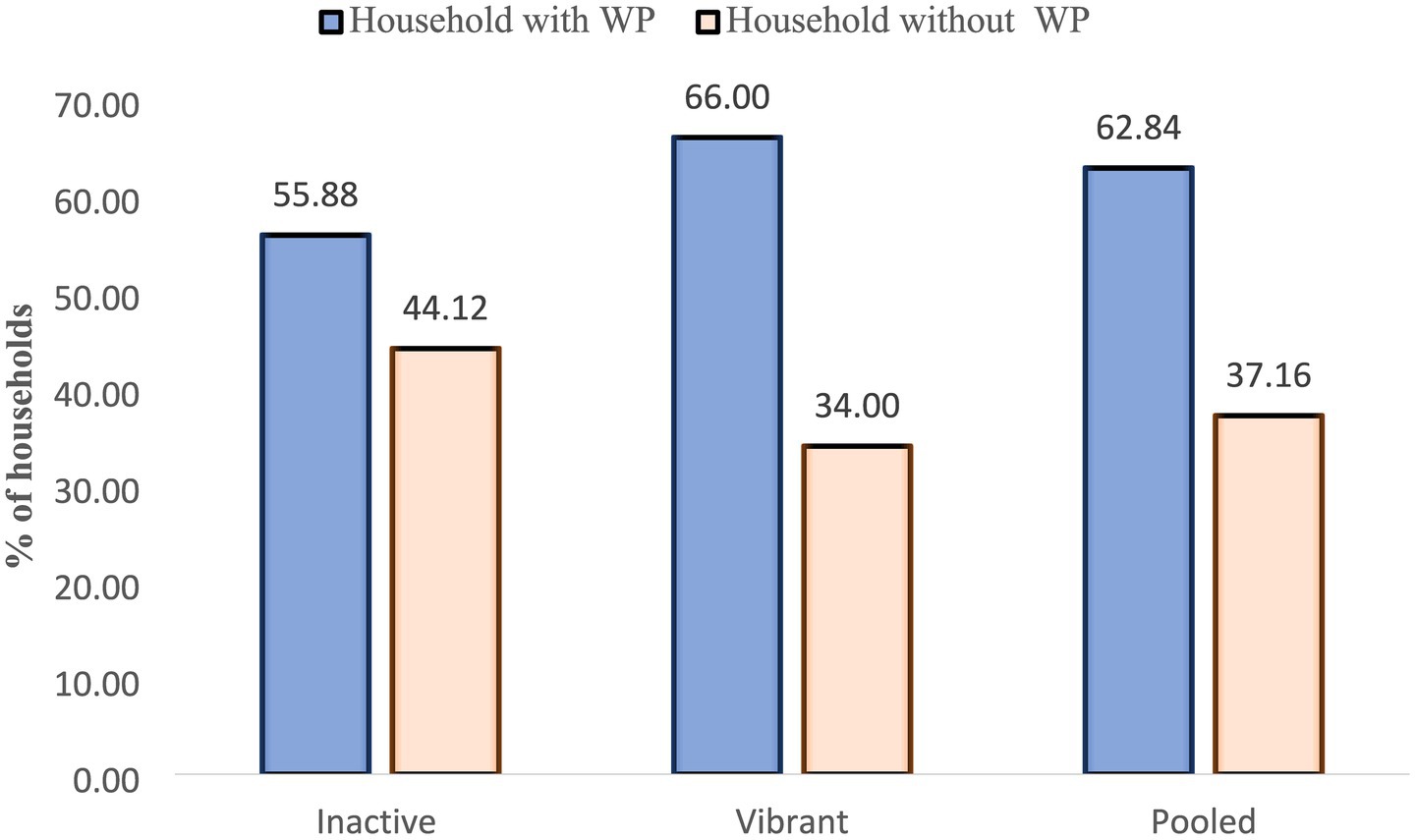
Figure 3. Distribution of WP in RUSACCO. “Inactive” and “vibrant” denote distinct groups already defined while “pooled” refers to the aggregation of these groups.
4.2 Factors influencing WP
The first stage of the sample selection process involves conducting a probit regression to analyze the factors influencing WP. For robustness checking, we present results from both the pooled and the matched samples. It is crucial to validate the quality of the matching to ensure that covariates are balanced, common support is established, and bias reduction is achieved, as illustrated in Figures 4, 5. The successful balancing of covariates and the reduction of bias through PSM confirm the robustness of our matching process and provide confidence in the validity of our results. A balanced distribution of covariates indicates that the matching process effectively mitigated any systematic differences between the two groups, thereby enhancing the comparability of treatment effects (Caliendo and Kopeinig, 2008; Leuven and Sianesi, 2018).
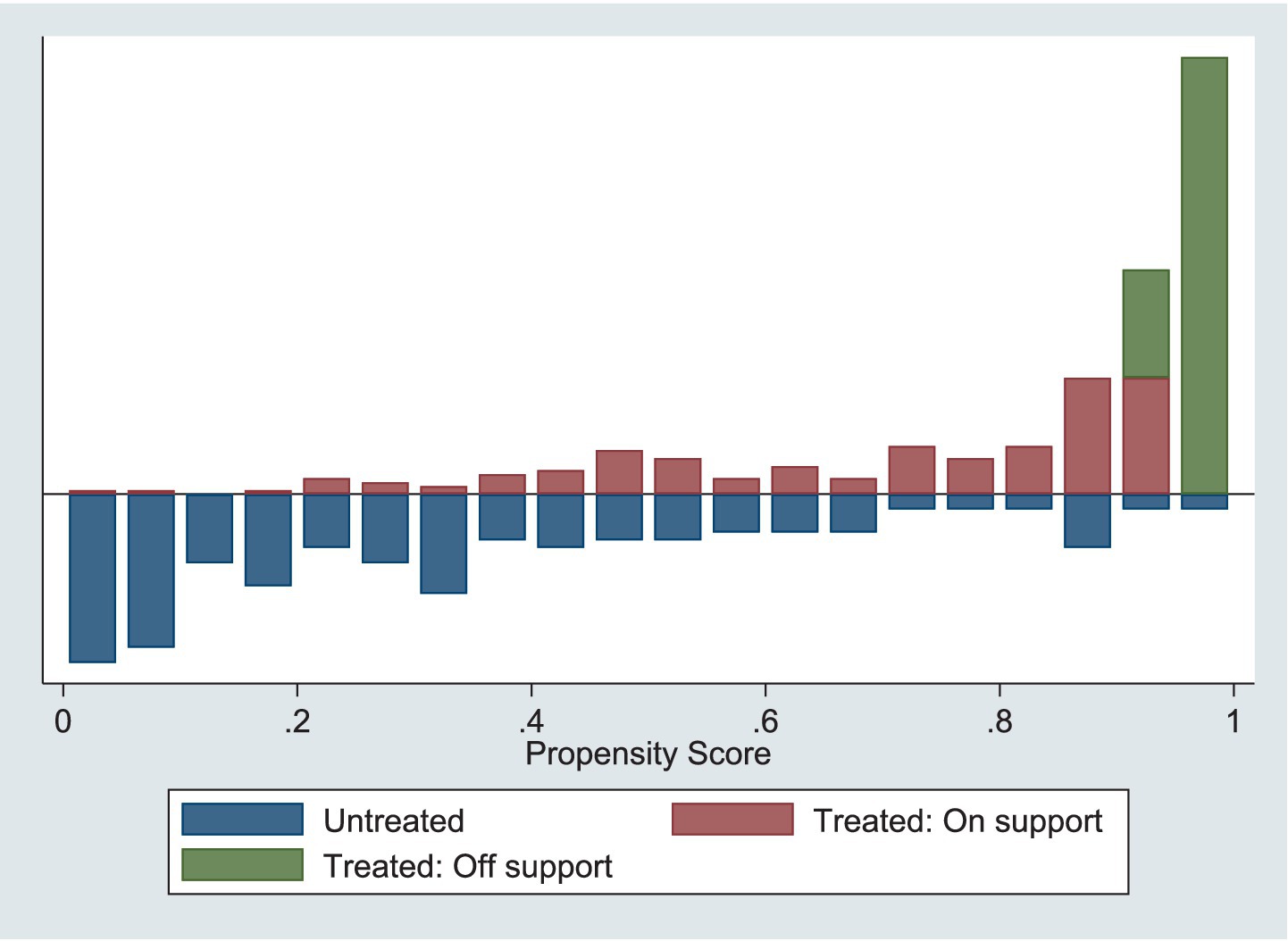
Figure 4. Balancing of covariates after 1–1 matching without replacement. 136 households with WP in RUSACCOs were off support.
Following the confirmation of satisfactory matching quality, as recommended by Caliendo and Kopeinig (2008), we present the factors influencing WP in RUSACCOs in Table 2 for both the matched subsample and the pooled sample. As matching adjusts for bias arising from observed characteristics, model diagnostics at the bottom of Table 2 indicate that the matched sample offers improved classification accuracy relative to the pooled sample. Nevertheless, the pooled results reinforce the robustness of the findings, demonstrating consistency in the estimated effects even in the absence of matching controls.
Regarding the determinants of WP in RUSACCOs, results from both models indicate that households headed by older individuals are less likely to exhibit WP. One possible explanation is that older household heads may place greater caregiving responsibilities on women, particularly in supporting elderly family members, thereby limiting women’s time and mobility to participate in cooperative activities (Glazebrook et al., 2020). Additionally, in both models, attaining basic education and training positively influences WP. This finding aligns with the agricultural literature, which highlights the role of education in equipping individuals with the skills and knowledge necessary to adopt innovative financing mechanisms like RUSACCOs (Gouët and Van Paassen, 2012). Education likely enhances women’s understanding of the benefits and operational dynamics of these cooperatives, fostering their participation. Furthermore, larger households are more likely to have WP in RUSACCOs. This could be due to greater labor division in larger households, which allows women to dedicate more time to cooperative involvement. It may also reflect the need for additional income sources in larger families, motivating women to seek financial opportunities through RUSACCO participation.
For the matched sample, we find that longer distances to markets have less influence on WP. This finding may be attributed to the role markets play as hubs for information exchange among rural women, offering insights into innovative agricultural practices and financing opportunities. However, for women who already access alternative sources of information, such as cooperatives or community networks, proximity to markets may become a less critical factor influencing their participation (Kropf et al., 2007; Tadesse and Bahiigwa, 2015).
Finally, prior knowledge of RUSACCO operations emerges as a significant determinant of WP, reinforcing its relevance as an instrumental variable. This indicates that awareness and understanding of the structure, functions, and potential benefits of RUSACCOs substantially enhance women’s likelihood of participation. Consequently, interventions that prioritize the dissemination of accurate and accessible information about cooperative operations may be essential in fostering greater women’s engagement in RUSACCOs.
4.3 Relationship between WP in RUSACCO and EE
Table 3 presents both the association and the estimated causal effect of WP on EE, using three different estimation strategies to ensure robustness and clarity in interpretation. However, it is important to acknowledge that while pre-matching estimates provide initial insights, they may be biased due to differences in observable characteristics between treatment and control groups. Post-matching estimates reduce this bias by improving comparability; however, they may still be subject to unobserved heterogeneity. This potential bias is reflected in the discrepancies observed in the estimated mean, minimum, and maximum values of EE reported at the bottom of the table. Given these limitations, greater confidence is placed in the estimates derived from the sample selection framework, which accounts for both observed and unobserved factors influencing selection into WP.
In the frontier model, we find that all inputs and the quantity of maize output produced positively and significantly influence the cost of production. Notably, across all model specifications, inefficiency accounts for variation in production costs, as evidenced by a lambda value greater than one (Adom and Adams, 2020; Bravo-Ureta et al., 2007). Regarding our primary inquiry, we find that WP in RUSACCOs in both the pooled and matched samples negatively and significantly influences economic inefficiency. This is further confirmed by the mean EE values of the sample selection for households with and without WP, showing an approximate 21% efficiency gap in favor of households with WP. This gap is higher than than found in Appiah-Twumasi et al. (2022) and Mustafa et al. (2024). The efficiency gains observed among women participating in RUSACCOs are likely linked to improved financial planning and input acquisition. This is reinforced by qualitative insights; one participant explained that “because I can now save and borrow from the cooperative, I plan better for each farming season.” Another highlighted that: “cooperative membership allowed me to avoid disruptions during planting—I do not have to wait anymore for someone to lend me money.” These reflections underscore how financial stability rather than technical support contributes to the significant efficiency gap observed in favor of households with WP.
In terms of the distribution of EE between households with WP and their counterparts, Figure 6 presents histograms and kernel density distributions to illustrate regions of concentration. Peaks in the distributions signify areas where the data are more concentrated, while troughs represent regions with less concentration. Analyzing the kernel density plots, it is important to note that a wider curve indicates higher variability, while a narrower curve suggests lower variability. Peaks in the density plot correspond to modes in the data distribution.
In general, households without WP exhibit a symmetric EE distribution while that of households with WP is skewed toward the 100%. While there is relatively more variability among households without FP, their counterparts are more concentrated around 90%. Households with WP display a unimodal distribution that is notably higher compared to the bimodal distribution among their counterparts. This suggests a higher level of consistency in TE among households with WP than those without. Importantly, the analysis acknowledges a methodological limitation linked to the valuation of family labor. Although the use of the prevailing regional wage rate is a standard practice in agricultural efficiency studies, it introduces variability due to regional wage dispersion and informal labor dynamics. Additionally, reliance on self-reported hours for family labor inputs may result in recall bias, particularly in cases where farmers do not systematically record working hours. While mitigation efforts (e.g., time-bound recall protocols) were employed during data collection, this limitation warrants consideration in interpreting efficiency estimates.
4.4 Unpacking the pathways to economic efficiency through AgI
While direct WP can trigger improvements in EE, it is also important to investigate other pathways in alignment with the implementation of the MAB program. To comprehensively examine the potential pathways underlying the WP-EE link, Table 4 presents the estimates of the CMP model. The negative and statistically significant correlation coefficient between the error terms, Rho, indicates the presence of negative selection bias. This validates the appropriateness of using CMP model to estimate the mediating effects of AgI reliably. Furthermore, it suggests that farmers’ decisions to adopt AgI are influenced by unobserved factors, such as innate farming talent or risk tolerance. Given the limited access to diverse extension services, farmers often mitigate risks by incorporating innovative practices, particularly in accessing information and financial solutions.
In the first equation of Table 4, WP in RUSACCOs is found to significantly enhance the likelihood of AgI. This is consistent with the understanding that access to financial services, particularly savings and credit, can ease liquidity constraints and enable women to invest in technologies that improve their farming practices (Amponsah et al., 2023; Mwalupaso et al., 2025). Through improved financial stability, women are more able to acquire mobile phones, radios, or even basic agri-informational services, laying the groundwork for digital adoption. On the other hand, the second equation focuses on the role of AgI in influencing EE, with results indicating a positive and statistically significant relationship. This confirms the mediating role of digital engagement between cooperative participation and improved efficiency outcomes. Such findings reinforce the argument that digital technologies, when made accessible and relevant, serve as catalysts for enhancing farm-level decision-making, market responsiveness, and resource optimization (Agyekumhene et al., 2018; Fabregas et al., 2019; Jenny, 2008).
However, these interpretations must be considered in light of certain methodological constraints. First, the measure of AgI is based on a binary variable indicating whether any adult in the household used digital tools. This approach, while pragmatic, arguably compresses a spectrum of digital behaviors into a single indicator. It does not account for the frequency, purpose, or complexity of tool usage, dimensions that can shape the impact of AgI on efficiency. For instance, using a phone to check rainfall updates occasionally is not equivalent to regular engagement with market platforms or weather forecasting tools (Tadesse and Bahiigwa, 2015). The measure thus captures adoption, but not depth or quality of usage. Additionally, the variable may conceal intra-household disparities. In households where men dominate tool access or decision-making, the recorded use might not reflect women’s empowerment or their ability to benefit directly from informatization.
Despite these limitations, qualitative feedback from women participants provides compelling evidence of the instrumental role that WP via digital access plays. One woman emphasized that “having access to savings and loans means I can buy inputs on time and not wait until the rains have started.” Another remarked that “after accessing credit, I now use my radio and phone to make my own farming plans which is helpful.” These reflections demonstrate how both access to financial services and digital tools are empowering women to make timely and independent agricultural decisions, thereby improving efficiency. Taken together, the findings suggest that RUSACCOs can serve not only as financial intermediaries but also as critical enablers of digital inclusion—provided that interventions recognize the diverse realities of women farmers.
Although digital tools like mobile phones and radios have penetrated many rural areas, their effective use still depends on literacy, digital skills, and infrastructure. Thus, scaling AgI as a mechanism for improving economic efficiency requires addressing educational and infrastructural barriers, especially among women. Recognizing these constraints is crucial for designing inclusive policies that leverage RUSACCOs not only as financial institutions but also as platforms for digital empowerment.
Beyond understanding the mediating effect of AgI, it is crucial to examine the pathway through which AgI influences EE. AgI has the potential to trigger various processes that improve EE. To explore this, we employed the CMP model with three equations consistent with the empirical strategy and the results are presented in Table 5.
The first equation of Table 5 reveals that AgI positively and significantly influences women’s empowerment, which some scholars also use as a proxy for gender equality consistent with the finding in Sekabira and Qaim (2017a). As households adopt digital tools for agricultural activities, women gain greater access to productive assets, such as financial resources, knowledge, and technology. This empowerment enhances their capacity to contribute meaningfully to agricultural processes.
Women’s empowerment, in turn, is strongly associated with an improved labor-land ratio consistent with Rasheed et al. (2020) and Vemireddy and Choudhary (2021). As women become more empowered, their active participation in agricultural production increases, leading to a better allocation of family labor relative to land use. This relationship highlights how gender equality and resource accessibility, facilitated by AgI, drive structural improvements in farm management practices.
Finally, our analysis establishes a robust link between the labor-land ratio and EE in maize production. A more balanced labor-land ratio, driven by increased women involvement, supports cost-efficient farming practices, improving overall EE. These findings affirm that WP in RUSACCOs enhances EE through a chain of effects: AgI fosters women’s empowerment, which improves the labor-land ratio, ultimately boosting EE. This is also confirmed by our robustness checking estimates from the SEM provided in Table A1.
4.5 Policy and practice implication
The findings of this study have significant policy implications for agricultural value chains. Promoting WP in RUSACCOs can enhance agricultural informatization, gender equality, and women’s empowerment in agriculture. By ensuring equitable access to agricultural assets, these policies support a more balanced and sustainable agricultural value chain. This empowerment not only improves individual productivity but also strengthens the overall resilience of the agricultural sector.
With only 6 years remaining until the deadline for the SDGs, it is crucial to maximize the contributions of women, who are often marginalized within the agricultural sector. Economically, WP could facilitate poverty alleviation through more efficiently produced maize, consistent with the SDGs (Adam et al., 2020; Tambo et al., 2021). For example, policy-relevant calculations demonstrate that if households without WP adopt it, they could close the efficiency gap and potentially save USD 65.64 annually in production costs (Table 6). This translates to daily savings of USD 0.18, which, given the new international poverty line of $2.15 per day, could result in an 8% reduction in extreme poverty. This impact is particularly significant in developing countries like Zambia.
Moreover, closing the efficiency gap could facilitate the production of more than 487 kg of maize per household, equating to a daily gain of 1,336 grams. Considering the average global daily food supply quantity of maize over the last 5 years, as reported by the Food and Agriculture Organization (FAO), of 49.23 grams per day, these gains would significantly improve maize supply, especially in Africa where maize consumption is high.
Given the implications for poverty reduction, governments and development organizations can create a more inclusive and efficient agricultural value chain by implementing six key policies and practices that empower women and enhance economic productivity.
1. Support and expansion of informal financial systems: Policymakers should support and expand informal financial systems such as RUSACCOs. Improving women’s access to credit is crucial for enhancing agricultural productivity EE in smallholder farming (Amponsah et al., 2023). Strengthening these financial systems enables women to invest more effectively in agricultural inputs and technologies, thus improving their position in the value chain.
2. Advancement of financial inclusion initiatives: Initiatives that prioritize financial inclusion for women should be promoted. Increased access to credit allows women to boost agricultural output, optimize resource allocation, and enhance labor efficiency as stressed by Ingutia and Sumelius (2024). This not only strengthens their role in the agricultural value chain but also contributes to a more productive sector.
3. Integration of financial inclusion into agricultural policies: Agricultural policies should integrate financial inclusion strategies to provide women with the necessary resources to fully engage in and contribute to agricultural productivity and food security consistent with more scholarly recommendation (Agyekumhene et al., 2018; Batung et al., 2023; Missiame et al., 2021; Owusu, 2017). This integration ensures that financial tools support and expand agricultural activities, reinforcing the value chain’s resilience and sustainability.
4. Targeted poverty reduction strategies: The potential to reduce extreme poverty by 8% through improved agricultural productivity underscores the need for targeted poverty reduction strategies. These strategies should focus on enhancing women’s financial capabilities, leading to more efficient and equitable participation in the agricultural value chain, thereby benefiting both the economic and social dimensions of farming communities.
5. Training and capacity-building programs: Training and capacity-building programs for women farmers are essential. These programs should focus on efficient farming techniques, financial literacy, and cooperative management skills to maximize the benefits of credit access. Such training enhances the skills and effectiveness of women within the agricultural value chain, leading to increased productivity and better resource management as detailed by Anderson et al. (2021).
6. Robust monitoring and evaluation frameworks: Robust monitoring and evaluation frameworks should be established to assess the impact of RUSACCOs and similar initiatives on women’s empowerment and agricultural productivity. By evaluating these programs, policymakers can scale successful models and refine strategies, ensuring that financial inclusion and women’s empowerment contribute effectively to a more robust and inclusive agricultural value chain as detailed in Amponsah et al. (2023).
In summary, fostering WP in RUSACCOs not only boosts agricultural productivity but also contributes to broader socio-economic development. Targeted policies and interventions that promote gender-inclusive financial and agricultural practices are essential for enhancing the efficiency and sustainability of agricultural value chains, ultimately supporting poverty alleviation and food security.
5 Conclusion
Investments in promoting WP in RUSACCO among smallholder farmers hold immense potential to enhance the efficiency of agricultural value chains and contribute to poverty reduction. Drawing on data from Zambia, where development partners have supported the formation of RUSACCOs, this study highlights the critical role of WP in improving EE. Our findings demonstrate that WP facilitates the adoption of AgI, enabling women to accumulate assets, overcome labor constraints, and better integrate into the agricultural value chain. These advancements enhance women’s contributions to maize production, optimizing input and technology use while reducing production costs—a vital outcome for food security and poverty alleviation. Notably, the study estimates that unlocking women’s potential in maize production could result in an 8% reduction in extreme poverty, aligning directly with the United Nations’ SDGs. These findings underscore the importance of scaling up initiatives such as RUSACCOs to further empower women and strengthen their position within the agricultural value chain.
Nonetheless, this study is not without limitations. First, while EE was the primary focus, allocative efficiency (AE) and technical efficiency (TE), which are key components of EE, were not part of the analysis. Understanding these components in isolation could provide more granular insights into how WP affects each aspect of efficiency, informing more targeted policy interventions. Second, the study relied on self-reported land sizes rather than GPS measurements, which may introduce measurement errors that affect EE calculations. Additionally, the valuation of family labor using regional wage rates is a common practice in productivity research, but it has limitations. Self-reported labor data may be subject to recall errors, and the use of regional wage rates assumes uniform opportunity costs, which may not fully reflect household-level variations. Future studies could explore alternative methods, such as time-use surveys or triangulated wage data, to enhance accuracy in labor valuation. Consequently, results should be interpreted with caution. Lastly, the cross-sectional nature of the data precludes tracking the long-term effects of WP on EE. Incorporating panel data in future research would allow for a more comprehensive understanding of temporal dynamics and the pathways linking WP to EE.
Despite these limitations, our study contributes valuable insights into the role of gender-inclusive financial practices in enhancing agricultural productivity and efficiency. It underscores the transformative impact of women’s empowerment on the agricultural value chain, using Zambia as a compelling case study for developing countries. To corroborate our findings, future research should address these limitations, particularly by exploring gender dynamics within agricultural cooperatives and employing longitudinal data to capture lagged effects. Overall, the study advocates for policies and practices that enhance financial inclusion and empower women, thereby strengthening the agricultural value chain and supporting broader socio-economic development goals.
Data availability statement
The raw data supporting the conclusions of this article will be made available by the authors, without undue reservation.
Ethics statement
The studies involving humans were approved by Prince G Consultancy and Academy. The studies were conducted in accordance with the local legislation and institutional requirements. The participants provided their written informed consent to participate in this study.
Author contributions
SW: Formal analysis, Writing – review & editing, Investigation, Visualization. GM: Methodology, Conceptualization, Project administration, Supervision, Writing – original draft. AK: Formal analysis, Methodology, Writing – review & editing.
Funding
The author(s) declare that no financial support was received for the research and/or publication of this article.
Conflict of interest
The authors declare that the research was conducted in the absence of any commercial or financial relationships that could be construed as a potential conflict of interest.
Generative AI statement
The authors declare that no Gen AI was used in the creation of this manuscript.
Publisher’s note
All claims expressed in this article are solely those of the authors and do not necessarily represent those of their affiliated organizations, or those of the publisher, the editors and the reviewers. Any product that may be evaluated in this article, or claim that may be made by its manufacturer, is not guaranteed or endorsed by the publisher.
References
Abdul Mumin, Y., Abu, B. M., and Nkegbe, P. K. (2024). “Conditional mixed process modeling: applications from the agriculture sector in Ghana” in Applied econometric analysis using cross section and panel data (Springer), 269–300.
Abdul-Rahaman, A., and Abdulai, A. (2018). Do farmer groups impact on farm yield and efficiency of smallholder farmers? Evidence from rice farmers in northern Ghana. Food Policy 81, 95–105. doi: 10.1016/j.foodpol.2018.10.007
Adam, R. I., Mmbando, F., Lupindu, O., Ubwe, R. M., Osanya, J., and Muindi, P. (2020). Beyond maize production: gender relations along the maize value chain in Tanzania. J. Gender Agric. Food Safety 5, 27–41. doi: 10.1177/0030727019888661
Adom, P. K., and Adams, S. (2020). Decomposition of technical efficiency in agricultural production in Africa into transient and persistent technical efficiency under heterogeneous technologies. World Dev. 129:104907. doi: 10.1016/j.worlddev.2020.104907
Agyekumhene, C., de Vries, J. R., van Paassen, A., Macnaghten, P., Schut, M., and Bregt, A. (2018). Digital platforms for smallholder credit access: the mediation of trust for cooperation in maize value chain financing. NJAS-Wageningen J. Life Sci. 86-87, 77–88. doi: 10.1016/j.njas.2018.06.001
Aigner, D., Lovell, C. K., and Schmidt, P. (1977). Formulation and estimation of stochastic frontier production function models. J. Econ. 6, 21–37. doi: 10.1016/0304-4076(77)90052-5
Amponsah, D., Awunyo-Vitor, D., Wongnaa, C. A., Prah, S., Sunday, O. A., and Acheampong, P. P. (2023). The impact of women groundnut farmers’ participation in village savings and loans association (VSLA) in northern Ghana. J. Agric. Food Res. 11:100481. doi: 10.1016/j.jafr.2022.100481
Anderson, C. L., Reynolds, T. W., Biscaye, P., Patwardhan, V., and Schmidt, C. (2021). Economic benefits of empowering women in agriculture: assumptions and evidence. J. Dev. Stud. 57, 193–208. doi: 10.1080/00220388.2020.1769071
Ankrah, D. A., Kwapong, N. A., Eghan, D., Adarkwah, F., and Boateng-Gyambiby, D. (2021). Agricultural insurance access and acceptability: examining the case of smallholder farmers in Ghana. Agric. Food Secur. 10, 1–14. doi: 10.1186/s40066-021-00292-y
Appiah-Twumasi, M., Donkoh, S. A., and Ansah, I. G. K. (2022). Innovations in smallholder agricultural financing and economic efficiency of maize production in Ghana’s northern region. Heliyon 8:e12087. doi: 10.1016/j.heliyon.2022.e12087
Ashe, J., and Neilan, K. J. (2014). In their own hands: how savings groups are revolutionizing development : Berrett-Koehler Publishers. doi: 10.48558/fvg8-7t72
Bannor, R. K., Oppong-Kyeremeh, H., Derkyi, M., Adombila, A. Y., and Amrago, E. C. (2020). Village savings and loans association participation and impact on off-farm income among rural women. J. Enterp. Communities 14, 539–562. doi: 10.1108/JEC-04-2020-0058
Batista, C., and Vicente, P. C. (2020). Improving access to savings through mobile money: experimental evidence from African smallholder farmers. World Dev. 129:104905. doi: 10.1016/j.worlddev.2020.104905
Battese, G. E., and Coelli, T. J. (1992). Frontier production functions, technical efficiency and panel data: with application to paddy farmers in India. J. Prod. Anal. 3, 153–169. doi: 10.1007/BF00158774
Battese, G. E., and Coelli, T. J. (1995). A model for technical inefficiency effects in a stochastic frontier production function for panel data. Empir. Econ. 20, 325–332. doi: 10.1007/BF01205442
Batung, E. S., Mohammed, K., Kansanga, M. M., Nyantakyi-Frimpong, H., and Luginaah, I. (2023). Credit access and perceived climate change resilience of smallholder farmers in semi-arid northern Ghana. Environ. Dev. Sustain. 25, 321–350. doi: 10.1007/s10668-021-02056-x
Bertolozzi-Caredio, D., Bardají, I., Garrido, A., Berry, R., Bijttebier, J., Gavrilescu, C., et al. (2021). Stakeholder perspectives to improve risk management in European farming systems. J. Rural. Stud. 84, 147–161. doi: 10.1016/j.jrurstud.2021.04.004
Boserup, E., Kanji, N., Tan, S. F., and Toulmin, C. (2013). Woman's role in economic development : Routledge. doi: 10.4324/9781315065892
Botreau, H., and Cohen, M. J. (2020). “Gender inequality and food insecurity: a dozen years after the food price crisis, rural women still bear the brunt of poverty and hunger” in Advances in food security and sustainability, vol. 5 (Elsevier), 53–117. Adv. Food Secur. Sustain.
Bravo-Ureta, B. E., Greene, W., and Solís, D. (2012). Technical efficiency analysis correcting for biases from observed and unobserved variables: an application to a natural resource management project. Empir. Econ. 43, 55–72. doi: 10.1007/s00181-011-0491-y
Bravo-Ureta, B. E., Solís, D., López, V. H. M., Maripani, J. F., Thiam, A., and Rivas, T. (2007). Technical efficiency in farming: a meta-regression analysis. J. Prod. Anal. 27, 57–72. doi: 10.1007/s11123-006-0025-3
Brunie, A., Rutherford, D., Keyes, E. B., and Field, S. (2017). Economic benefits of savings groups in rural Mozambique. Int. J. Soc. Econ. 44, 1988–2001. doi: 10.1108/IJSE-04-2015-0103
Burke, W. J., Frossard, E., Kabwe, S., and Jayne, T. S. (2019). Understanding fertilizer adoption and effectiveness on maize in Zambia. Food Policy 86:101721. doi: 10.1016/j.foodpol.2019.05.004
Burke, W. J., Hichaambwa, M., Banda, D., and Jayne, T. S. (2011). The cost of maize production by smallholder farmers in Zambia.
Burke, W. J., Morgan, S. N., Namonje, T., Muyanga, M., and Mason, N. M. (2023). Beyond the “inverse relationship”: area mismeasurement may affect actual productivity, not just how we understand it. Agric. Econ. 54, 557–569. doi: 10.1111/agec.12775
Caliendo, M., and Kopeinig, S. (2008). Some practical guidance for the implementation of propensity score matching. J. Econ. Surv. 22, 31–72. doi: 10.1111/j.1467-6419.2007.00527.x
Castleberry, A., and Nolen, A. (2018). Thematic analysis of qualitative research data: is it as easy as it sounds? Curr. Pharm. Teach. Learn. 10, 807–815. doi: 10.1016/j.cptl.2018.03.019
Coelli, T. J., Rao, D. S. P., O'donnell, C. J., and Battese, G. E. (2005). An introduction to efficiency and productivity analysis : Springer Science & Business Media. doi: 10.1007/0-387-25895-7_4.pdf
Connelly, N. A., Brown, T. L., and Knuth, B. A. (2000). Assessing the relative importance of recall bias and nonresponse bias and adjusting for those biases in statewide angler surveys. Hum. Dimens. Wildlife 5, 19–29. doi: 10.1080/10871200009359192
Darity, W. A. (1980). The Boserup theory of agricultural growth: a model for anthropological economics. J. Dev. Econ. 7, 137–157. doi: 10.1016/0304-3878(80)90001-2
Dawuni, P., Mabe, F. N., and Tahidu, O. D. (2021). Effects of village savings and loan association on agricultural value productivity in northern region of Ghana. Agric. Finance Rev. 81, 657–674. doi: 10.1108/AFR-02-2020-0024
De Groote, H., Gitonga, Z. M., and Sonder, K. (2023). Maize storage losses, climate, and climate change in Zambia. Food Secur. 15, 879–899. doi: 10.1007/s12571-023-01347-7
Dlamini, N., and Mpanza, S. (2020). Experiences of savings groups that promise a Liberatory financial education for farming-dependent enterprises. Public Admin. Dev. Alternat. The 5th Annual International Conference on Public Administration and Development Alternatives 07 - 09 October 2020, Virtual Conference. 731.
Doss, C. R. (2018). Women and agricultural productivity: reframing the issues. Dev. Policy Rev. 36, 35–50. doi: 10.1111/dpr.12243
Duncan, E., Abdulai, A.-R., and Fraser, E. D. (2021). Modernizing agriculture through digital technologies: prospects and challenges. Handb. Huma. Impact Agric., 138–161. doi: 10.4337/9781839101748.00018
Fabregas, R., Kremer, M., and Schilbach, F. (2019). Realizing the potential of digital development: the case of agricultural advice. Science 366:eaay3038. doi: 10.1126/science.aay3038
GHI. (2016). Global Hunger Index. Available online at: http://ghi.ifpri.org/countries/HTI/ (Accessed 10 November, 2024).
Glazebrook, T., Noll, S., and Opoku, E. (2020). Gender matters: climate change, gender bias, and women’s farming in the global south and north. Agriculture 10:267. doi: 10.3390/agriculture10070267
Goedde, L., McCullough, R., Ooko-Ombaka, A., and Pais, G. (2021). How digital tools can help transform African Agri-food systems. New York, London: McKinsey Co.
Gouët, C., and Van Paassen, A. (2012). Smallholder marketing cooperatives and smallholders’ market access: lessons learned from the actors involved. J. Agric. Educ. Ext. 18, 369–385. doi: 10.1080/1389224X.2012.691784
Greene, W. (2010). A stochastic frontier model with correction for sample selection. J. Prod. Anal. 34, 15–24. doi: 10.1007/s11123-009-0159-1
Griliches, Z. (1963). Estimates of the aggregate agricultural production function from cross-sectional data. J. Farm Econ. 45, 419–428. doi: 10.2307/1235997
Hagen, B. N., Sawatzky, A., Harper, S. L., O’Sullivan, T. L., and Jones-Bitton, A. (2022). “Farmers aren’t into the emotions and things, right?”: a qualitative exploration of motivations and barriers for mental health help-seeking among Canadian farmers. J. Agromedicine 27, 113–123. doi: 10.1080/1059924X.2021.1893884
Ingutia, R., and Sumelius, J. (2024). Does cooperative membership facilitate access to credit for women farmers in rural Kenya? J. Agric. Food Res. 18:101425. doi: 10.1016/j.jafr.2024.101425
Janvry, A. D., and Sadoulet, E. (2006). “Progress in the modeling of rural households’ behavior under market failures” in Poverty, inequality and development (Springer), 155–181.
Jenny, A. (2008). Does digital divide or provide? The impact of cell phones on grain markets in Niger. SSRN Electr. J. 154. doi: 10.2139/ssrn.1093374
Kabeer, N. (1999). The conditions and consequences of choice: Reflections on measurement of women's empowerment, vol. 108. Geneva: United Nations Institute for Social Development.
Karlan, D., Savonitto, B., Thuysbaert, B., and Udry, C. (2017). Impact of savings groups on the lives of the poor. Proc. Natl. Acad. Sci. 114, 3079–3084. doi: 10.1073/pnas.1611520114
Kesanta, J., and Andre, B. (2015). Impact of women empowered through community savings groups on the wellbeing of their families: a study from Mgubwe, Tanzania. Int. J. Best Practi. Global Dev. 1:4.
Kikulwe, E. M., Fischer, E., and Qaim, M. (2014). Mobile money, smallholder farmers, and household welfare in Kenya. PLoS One 9:e109804. doi: 10.1371/journal.pone.0109804
Kropf, M. L., Holben, D. H., Holcomb, J. P. Jr., and Anderson, H. (2007). Food security status and produce intake and behaviors of special supplemental nutrition program for women, infants, and children and farmers’ market nutrition program participants. J. Am. Diet. Assoc. 107, 1903–1908. doi: 10.1016/j.jada.2007.08.014
Kuklys, W. (2005). Amartya Sen's capability approach: Theoretical insights and empirical applications. Berlin: Springer Science & Business Media.
Kumar, N., Raghunathan, K., Arrieta, A., Jilani, A., and Pandey, S. (2021). The power of the collective empowers women: evidence from self-help groups in India. World Dev. 146:105579. doi: 10.1016/j.worlddev.2021.105579
Lawin, K. G., and Tamini, L. D. (2019). Tenure security and farm efficiency analysis correcting for biases from observed and unobserved variables: evidence from Benin. J. Agric. Econ. 70, 116–134. doi: 10.1111/1477-9552.12275
Leuven, E., and Sianesi, B. (2018). PSMATCH2: Stata module to perform full Mahalanobis and propensity score matching, common support graphing, and covariate imbalance testing.
Li, J., Ma, W., and Gong, B. (2023). Market participation and subjective well-being of maize farmers. Econ. Anal. Policy 80, 941–960. doi: 10.1016/j.eap.2023.09.037
Lomax, R. G., and Schumacker, R. E. (2004). A beginner's guide to structural equation modeling. New York: Psychology Press. doi: 10.4324/9781410610904
Mason, N. M., Wineman, A., and Tembo, S. T. (2020). Reducing poverty by ‘ignoring the experts’? Evidence on input subsidies in Zambia. Food Secur. 12, 1157–1172. doi: 10.1007/s12571-020-01032-z
Mbudzya, J. J., Gido, E. O., and Owuor, G. (2022). Effect of land tenure security on agricultural productivity among small scale farmers in Kenya: a conditional mixed processes analysis. Cogent Food Agric. 8:2139805. doi: 10.1080/23311932.2022.2139805
Missiame, A., Nyikal, R. A., and Irungu, P. (2021). What is the impact of rural bank credit access on the technical efficiency of smallholder cassava farmers in Ghana? An endogenous switching regression analysis. Heliyon 7:e07102. doi: 10.1016/j.heliyon.2021.e07102
Mulenga, B. P., Ngoma, H., and Nkonde, C. (2021). Produce to eat or sell: panel data structural equation modeling of market participation and food dietary diversity in Zambia. Food Policy 102:102035. doi: 10.1016/j.foodpol.2021.102035
Mustafa, P. G., Wang, S., Mwalupaso, G. E., Yu, Y., and Li, Z. (2024). The effect of climate-smart agriculture on productivity and cost efficiency: insights from smallholder wheat producers in Pakistan. Agric. Econ. 70, 334–348. doi: 10.17221/74/2024-AGRICECON
Mwalupaso, G. E., Wang, S., Geng, X., and Kipkogei, S. (2025). Bridging credit gaps for sustainable agriculture: the role of rural savings and credit cooperatives among smallholder farmers. Agric. Econ. 71, 254–272. doi: 10.17221/436/2024-AGRICECON
Mwalupaso, G. E., Wang, S., Rahman, S., Alavo, E. J.-P., and Tian, X. (2019). Agricultural informatization and technical efficiency in maize production in Zambia. Sustainability 11:2451. doi: 10.3390/su11082451
Mwalupaso, G. E., Wang, S., Xu, Z., and Tian, X. (2019). Towards auspicious agricultural Informatization—implication of farmers’ behavioral intention apropos of Mobile phone use in agriculture. Sustainability 11:6282. doi: 10.3390/su11226282
Mwanamwenge, M., and Harris, J. (2017). Agriculture, food systems, diets and nutrition in Zambia. Hivos: Discussion Paper.
Owusu, S. (2017). Effect of access to credit on agricultural productivity: evidence from cassava farmers in the afigya-kwabre district of Ghana. Int. J. Innov. Res. Soc. Sci. Strat. Manag. Techn. 4, 55–67.
Pollak, R. A. (2003). Gary Becker's contributions to family and household economics. Rev. Econ. Househ. 1, 111–141. doi: 10.1023/A:1021803615737
Rahman, S. (2010). Women’s labour contribution to productivity and efficiency in agriculture: empirical evidence from Bangladesh. J. Agric. Econ. 61, 318–342. doi: 10.1111/j.1477-9552.2010.00243.x
Rasheed, A., Mwalupaso, G., Abbas, Q., Tian, X., and Waseem, R. (2020). Women participation: a productivity strategy in rice production. Sustainability 12:2870. doi: 10.3390/su12072870
Rickard, K. (2022). “Enhancing women's empowerment through savings groups” in Transforming Africa: How savings groups Foster Financial inclusion, resilience and economic development (Leeds, England: Emerald Publishing Limited), 45–58.
Rogers, E. M., Singhal, A., and Quinlan, M. M. (2014). Diffusion of innovations In D. W. Stacks, & M. B. Salwen (Eds.), An integrated approach to communication theory and research (Routledge), 432–448.
Rosenbaum, P. R., and Rubin, D. B. (1983). The central role of the propensity score in observational studies for causal effects. Biometrika 70, 41–55. doi: 10.1093/biomet/70.1.41
Samboko, P. C., Sambo, J., and Luhana, J. (2018). Agricultural finance in Zambia: how can smallholder inclusion be deepened? Indaba Agricultural Policy Research Institute. Available at: https://www.researchgate.net/profile/Paul-Samboko-2/publication/331097068_AGRICULTURAL_FINANCE_IN_ZAMBIA_HOW_CAN_SMALLHOLDER_INCLUSION_BE_DEEPENED/links/5c6574fd92851c48a9d3c79e/AGRICULTURAL-FINANCE-IN-ZAMBIA-HOW-CAN-SMALLHOLDER-INCLUSION-BE-DEEPENED.pdf
Schoofs, A. (2022). Promoting financial inclusion for savings groups: a financial education programme in rural Rwanda. J. Behav. Exp. Financ. 34:100662. doi: 10.1016/j.jbef.2022.100662
Sekabira, H., and Qaim, M. (2017a). Can mobile phones improve gender equality and nutrition? Panel data evidence from farm households in Uganda. Food Policy 73, 95–103. doi: 10.1016/j.foodpol.2017.10.004
Sekabira, H., and Qaim, M. (2017b). Mobile money, agricultural marketing, and off-farm income in Uganda. Agric. Econ. 48, 597–611. doi: 10.1111/agec.12360
Sharma, A., and Zhao, H. (2017). Study of village savings and loans associations (VSLAs) and their ability to address credit needs of small holder farmers in southern Tanzania. Available at: https://hdl.handle.net/1813/57407
Sianesi, B. (2001). Implementing propensity score matching estimators with Stata. Paper Presented at the UK Stata Users Group, VII Meeting.
Sibhatu, K. T., Arslan, A., and Zucchini, E. (2022). The effect of agricultural programs on dietary diversity and food security: insights from the smallholder productivity promotion program in Zambia. Food Policy 113:102268. doi: 10.1016/j.foodpol.2022.102268
Sihlobo, W. (2018). South Africa and Zambia’s maize supplies are in good shape. Available online at: https://wandilesihlobo.com/2018/08/10/south-africa-and-zambias-maize-supplies-are-in-good-shape/ (Accessed August 09, 2024).
Silva, J. V., Baudron, F., Ngoma, H., Nyagumbo, I., Simutowe, E., Kalala, K., et al. (2023). Narrowing maize yield gaps across smallholder farming systems in Zambia: what interventions, where, and for whom? Agron. Sustain. Dev. 43:26. doi: 10.1007/s13593-023-00872-1
Sishumba, J., and Mulonda, M. (2019). Village banking: a feasible tool for accelerating financial inclusion for the unbanked poor communities in Zambia. J. Huma. Social Sci. Stud. 1, 51–62.
Strang, K. D., Che, F., and Vajjhala, N. R. (2022). Thematic analysis of agricultural government policy and operational problems. Agric. Res. 11, 549–556. doi: 10.1007/s40003-021-00588-2
Tadesse, G., and Bahiigwa, G. (2015). Mobile phones and farmers’ marketing decisions in Ethiopia. World Dev. 68, 296–307. doi: 10.1016/j.worlddev.2014.12.010
Tambo, J. A., Matimelo, M., Ndhlovu, M., Mbugua, F., and Phiri, N. (2021). Gender-differentiated impacts of plant clinics on maize productivity and food security: evidence from Zambia. World Dev. 145:105519. doi: 10.1016/j.worlddev.2021.105519
Tambo, J. A., and Wünscher, T. (2018). Building farmers' capacity for innovation generation: insights from rural Ghana. Renew. Agric. Food Syst. 33, 116–130. doi: 10.1017/S1742170516000521
Tarrant, M. A., Manfredo, M. J., Bayley, P. B., and Hess, R. (1993). Effects of recall bias and nonresponse bias on self-report estimates of angling participation. N. Am. J. Fish Manag. 13, 217–222. doi: 10.1577/1548-8675(1993)013<0217:EORBAN>2.3.CO;2
Vatsa, P., Ma, W., Zheng, H., and Li, J. (2023). Climate-smart agricultural practices for promoting sustainable agrifood production: yield impacts and implications for food security. Food Policy 121:102551. doi: 10.1016/j.foodpol.2023.102551
Vemireddy, V., and Choudhary, A. (2021). A systematic review of labor-saving technologies: implications for women in agriculture. Glob. Food Sec. 29:100541. doi: 10.1016/j.gfs.2021.100541
WFP. (2024). Food security cluster joint rapid assessment report. Available online at: https://reliefweb.int/report/zambia/food-security-cluster-joint-rapid-assessment-report-march-2024 (Accessed November 10, 2024).
Workman, D. (2018). Zambia’s top 10 exports. Available online at: http://www.worldstopexports.com/zambias-top-10-exports/ (Accessed August 09, 2024).
Appendix A
Keywords: gender equality, maize production, agricultural informatization, financial inclusion, economic efficiency, rural agricultural development
Citation: Wang S, Mwalupaso GE and Akter A (2025) Nexus of women’s participation in smallholder financial inclusion programs and economic efficiency: implications for poverty alleviation. Front. Sustain. Food Syst. 9:1613678. doi: 10.3389/fsufs.2025.1613678
Edited by:
Nugun P. Jellason, Teesside University, United KingdomReviewed by:
Anne Namatsi Lutomia, Purdue University, United StatesJoão Leite, Federal University of the Southern Frontier, Brazil
Copyright © 2025 Wang, Mwalupaso and Akter. This is an open-access article distributed under the terms of the Creative Commons Attribution License (CC BY). The use, distribution or reproduction in other forums is permitted, provided the original author(s) and the copyright owner(s) are credited and that the original publication in this journal is cited, in accordance with accepted academic practice. No use, distribution or reproduction is permitted which does not comply with these terms.
*Correspondence: Gershom Endelani Mwalupaso, cmluc2NvZEBnbWFpbC5jb20=
 Shangao Wang
Shangao Wang Gershom Endelani Mwalupaso
Gershom Endelani Mwalupaso Asma Akter3,4
Asma Akter3,4